








siteselection.com/cc/utah
8 BOARD MEMBERS
Meet the Utah Governor’s Office of Economic Development Board of Directors.
10 BUSINESS CLIMATE OVERVIEW
Utah’s on a relentless mission to improve its environment for business.
12 GOVERNOR INTERVIEW
Over the last decade, Gov. Gary Herbert focused on economic development, cutting red tape and giving Utah a competitive edge.
16 LEADERSHIP INTERVIEW
Val Hale, executive director of the Utah Governor’s Office of Economic Development, shares his strategic approach to elevating business in the state.
20 STATISTICAL PROFILE
Utah’s economy in facts and figures.
24 BUSINESS-FRIENDLY RESOURCES
Utah is embracing the country’s changing economic landscape and reaping the rewards.

28 OPPORTUNITY ZONES AND MEGA SITES
Mega sites and Opportunity Zones aim to encourage investment in rural and economically distressed communities across the state.

30 CORPORATE RECRUITMENT
Technology companies are setting up shop on Utah’s Silicon Slopes for much less than they can in Silicon Valley.
32 WORKFORCE
Nine things to know about Utah’s highly skilled workforce.
34 MILLENNIALS AND POPULATION GROWTH
Young people are driving Utah’s massive population growth.
36 ENTREPRENEURSHIP AND INNOVATION
Tech startups are crossing state lines to do business in the Beehive State.
38 MASTERS OF BUSINESS CREATION
A first-of-its-kind program for entrepreneurs is offered at The University of Utah.
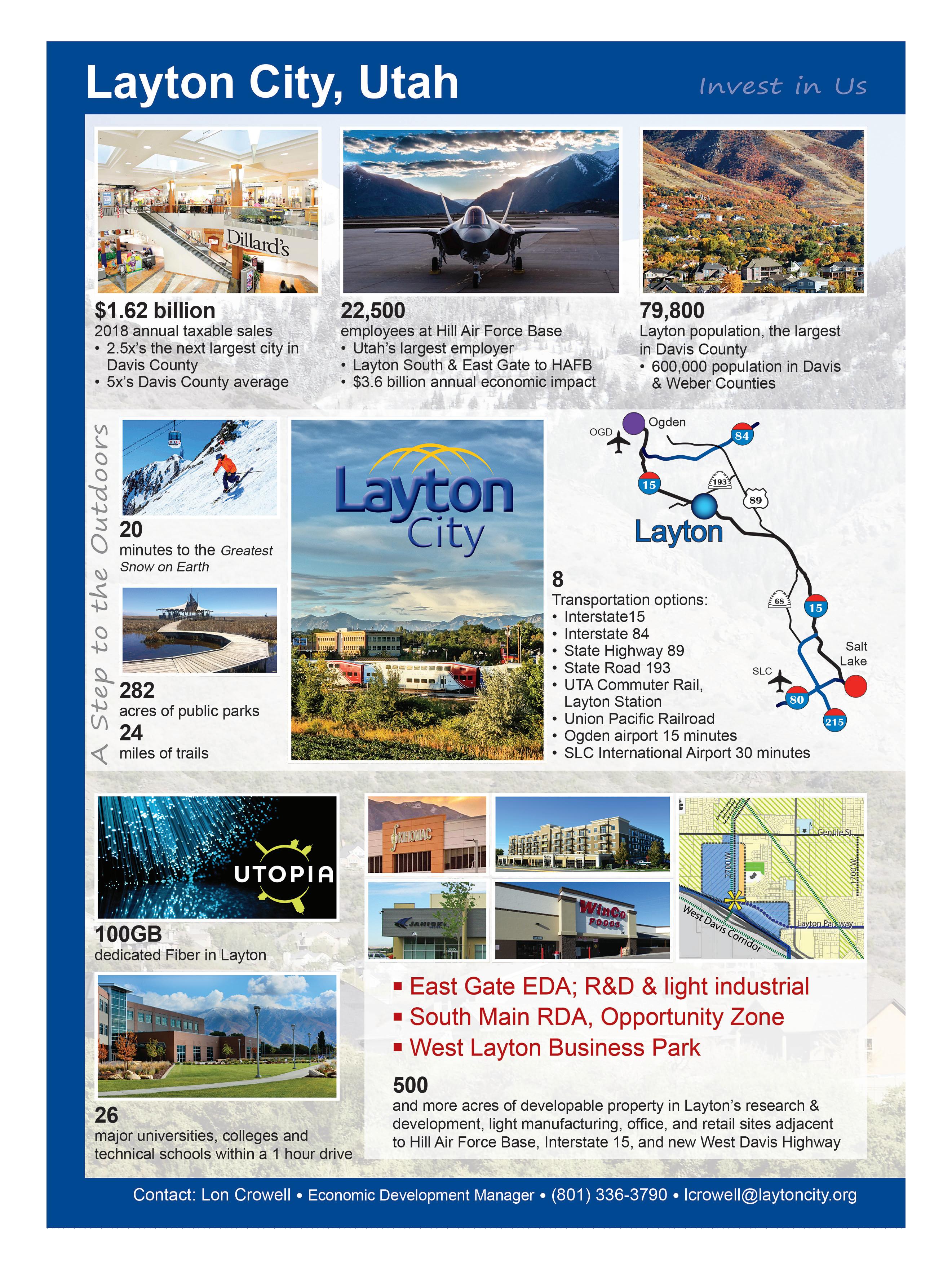
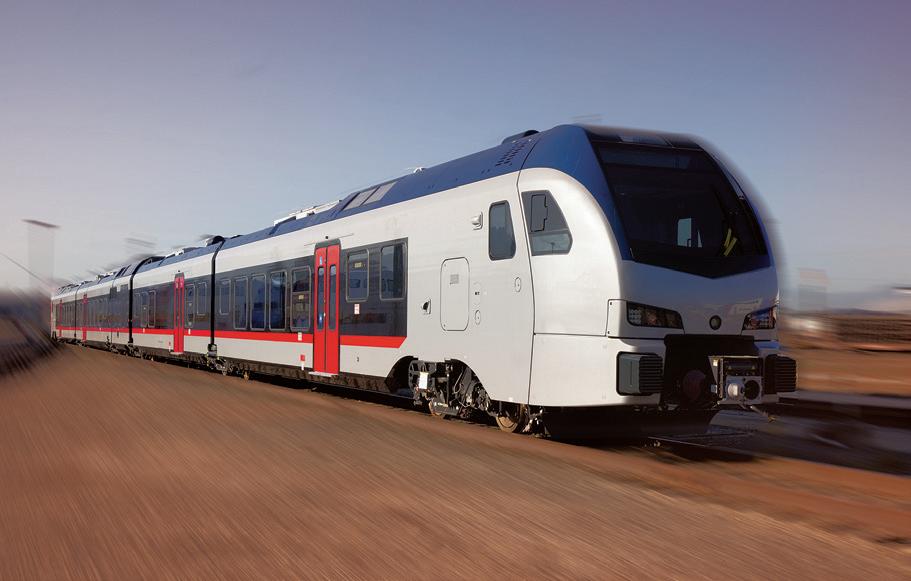
40 HIGHER EDUCATION
Utah’s institutions of higher education offer affordable and accessible opportunities to the benefit of workers and companies alike.
42 LOCAL LEADERS
Meet the leaders of three Utah communities: Duchesne County, Helper and Moab.
48 AEROSPACE AND DEFENSE
Home to 46 airports as well as companies like Boeing, Orbital ATK and Northrop Grumman, Utah’s aerospace and defense sector is in good company.
52 ENERGY
Utah is a conventional and renewable energy powerhouse.
54 FINANCIAL SERVICES
From major banks to community credit unions, Utah’s financial services sector is growing by the day.
56 LIFE SCIENCES
Utah’s life science industry offers the state’s diverse economy a high degree of resiliency.
58 OUTDOOR PRODUCTS AND RECREATION
Utah’s outdoor recreational opportunities and favorable business climate have created the perfect atmosphere for outfitting manufacturers.
Utah’s massive technology industry is attracting giants like Facebook, Adobe and many more.
From the Utah Inland Port to Salt Lake City International Airport, the Beehive State is investing heavily to prepare for population growth.
68
From road sensors to oat milk, foreign-owned companies are making products like these and many more in the Beehive State.
70
Utah’s status as the crossroads of the West was firmly established 150 years ago with the Transcontinental Railroad. Today, the state is even more connected.
72
With stunning mountains, five national parks, pristine rivers and the “Greatest Snow On Earth,” life in Utah is an adventure of its own.

74
79
80
Contact information for Utah’s economic development organizations.


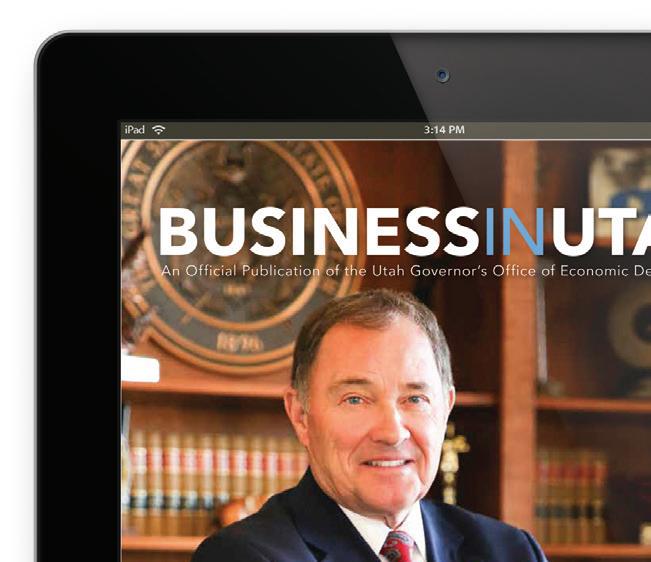




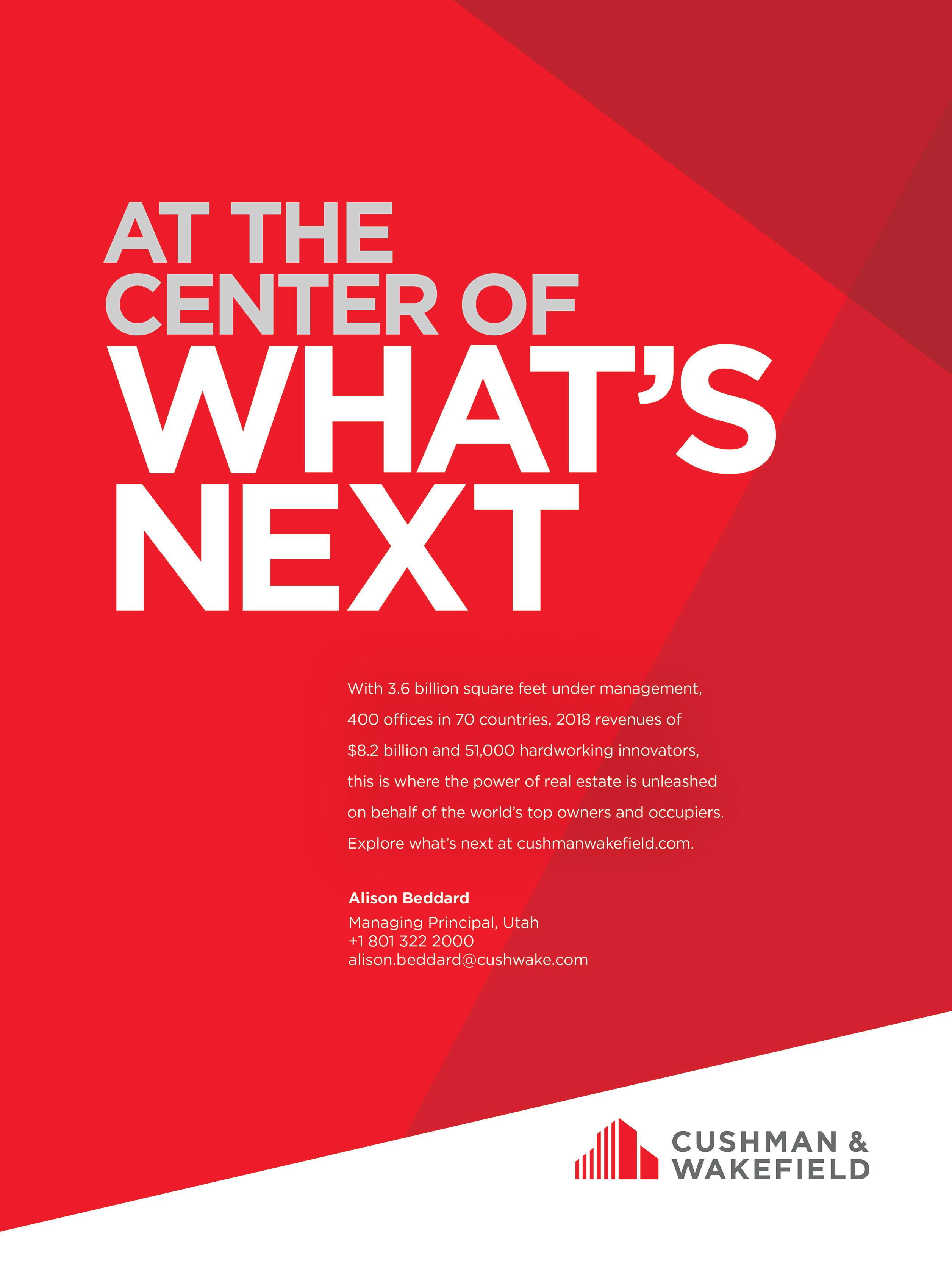


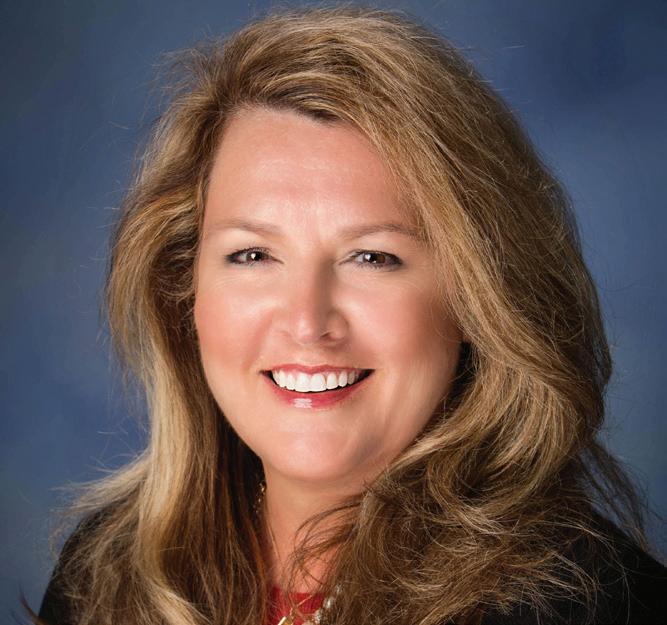















ow do you change someone’s perception about a state as a prospective destination for business? In Utah’s case, it’s easy. You invite that person to visit.
The Economic Development Corporation of Utah (EDCUtah) recently published its annual Site Selector Perception Study, a survey the organization has been conducting for many years to identify what matters most in corporate relocation and measure how Utah performs across decision drivers.
“Site selectors are key players when it comes to business relocation decisions,” said Theresa Foxley, president and CEO of EDCUtah. “This study gives insight into how the consulting process works, as well as extensive data about how site selectors view Utah as a relocation option.”
The survey revealed quality of labor as the most important decision driver that site selectors’ clients are considering when looking to relocate. Other key drivers include availability of experienced labor, business-friendly government and labor costs.

“Site selectors indicated that Utah excels at quality of life, quality of labor and cost of living, as well as other important elements such as government attitude toward business, and low labor costs,” the report stated, adding that “site selectors who have visited Utah not only have a greater understanding of the state’s value, but also are more likely to recommend Utah to a client.”
Foxley says she has seen firsthand the effect that a personal visit has on a site selector. “The light bulb switches on,” she says. “They see that our airport is only 10 minutes from the urban core of Salt Lake City. They see that our labor pool is very dense. More than 80% of it is within an 80mile stretch.”

She adds that site selectors will also see the benefits of recent business climate enhancements. “The state underwent serious regulatory reform under Gov. Gary Herbert,” she notes. “If the regulations did not serve a valid purpose, they were rolled back. Next, we’re going to look at overall reduction of state taxes. Tax reform in Utah will be very broad-based to make our state ready for a more services- and experience-based economy.”
U.S. News & World Report released its Best States Rankings for 2019 and named Utah the No. 4 Best State Overall, No. 2 in Economy, No. 3 in Infrastructure, No. 5 in Fiscal Stability and No. 9 in Health Care.
The Governor’s Office of Economic Development notes that Utah does not produce strong communities without building strong industries. It targets six industry sectors for business retention, expansion and recruitment: aerospace, energy, financial services, life sciences, outdoor recreation, and software and information technology. The performance of each is robust:
• As of 2018, Utah’s aerospace industry accounted for 944 establishments employing 31,390 workers in high-wage occupations. PwC ranks Utah No. 4 in the nation for aerospace manufacturing attractiveness, due in large part to the state’s talent pool.
• Energy and minerals play a vital role in Utah’s economy, contributing $20 billion to the economy and approximately 50,000 high-paying jobs.
• Utah ranks No. 8 in the U.S. for banking assets and has a burgeoning fintech sector.
• On average in Utah, life science jobs pay about 161% of the state’s average annual wage, and these jobs are increasing. Life science employment in Utah grew by 25.8% from 2001 to 2010.
• Outdoor recreation contributes more than $12.3 billion to the economy, employs more than 110,000 people and is a primary driver behind the tourism sector. Outdoor recreation tourism creates $737 million in state and local tax revenues and is responsible for another $3.9 billion in wages.
• As of 2018, Utah’s tech industry accounted for 4,201 business establishments and 68,184 workers, and Forbes named Salt Lake City the No. 1 American city that is “Poised to Become Tomorrow’s Tech Mecca.”
Gov. Herbert promises that this success will endure. “This isn’t a flash in the pan,” he said. “It’s sustainable economic development that comes from staying the course, providing fertile soil for job growth, and a pro-business environment. Utah is large enough to support business growth and nimble enough to get things done.”





























































































































It’s one thing to say you are going to deliver a competitive business climate. It’s entirely another thing to do it.
In Utah, Gov. Gary Herbert has racked up an impressive track record of delivering on his promises when it comes to economic development. Since becoming governor of Utah in 2009, Herbert has made it his mission to get state government out of the way of business and do everything he can to smooth the avenues of commerce.
Huge project wins like Facebook, Adobe, eBay and PayPal don’t occur in a vacuum. They happen because the people who run those global companies see an opportunity for growth and profitability near the slopes of Utah’s majestic mountains.
In the following interview, Gov. Herbert explains his approach to economic development.
You have made cutting red tape a tenet of your administration since you were first elected in 2009. Why is that so important to you and your state?
GOV. GARY HERBERT: It is important to the business sector. To have a healthy economy, you don’t want the burden of a lot of regulations. The business community complains most about the burden of overregulation around the country. We have had a significant effort to eliminate nonsensical regulations in Utah. We want to enable wealth creators and risk takers. We want to give them an ability to innovate and find niches in the marketplace.





 Photo: Getty Images
Photo: Getty Images



efficiency in state government, and an attitude that we want you to be successful and profitable. We want to keep government off your backs and out of your wallets.
Facebook was one of your biggest project wins of 2018. How did Utah accomplish this deal?
GOV. HERBERT: It takes effort and better communication and being able to present what you have to offer. If you want to increase your bottom line and
ventures to Eagle Mountain. They are now our anchor tenant. It will be a catalyst for economic growth.
Will you make a concerted effort to bring the Winter Olympics back to Utah in 2034?
GOV. HERBERT: We had a great success in 2002 hosting the Winter Olympics. It was supported by the public at large in Utah. It was arguably the best Winter Olympics in the history of the Olympic Games. We made a net profit of about





















$100 million. That puts us in a good position to win the 2034 games. The U.S. Olympic Committee agrees. We still have to be chosen by the International Olympic Committee. We have the venues, the convenience, etc. We will have a newly renovated and modernized airport, and we are an ideal location. With 87% support of the Utah people, we have all the necessary ingredients to be successful.
A brand-new airport will open in Salt Lake City in 2020. What will that mean for your state?
GOV. HERBERT: We have always been known as the Crossroads of the West. Geographical location has always been one of the secrets of our success. Utah is a day’s drive to the West Coast, the Midwest, Canada and Mexico. We are the bullseye in the target. Our airport has grown dramatically to 20 million flights per year. This $3.6 billion airport expansion and remodeling is being paid for by travelers. It will be the most modern airport in America. Hundreds of additional new jobs plus thousands of jobs in construction are being created by this project, and we are putting in an inland port next to it. A lot of great things are happening.
A popular bike maker recently relocated from California to Utah. Why do so many California companies choose to expand in your state?
GOV. HERBERT: We are business friendly. We are a place where if you want to improve your bottom line and increase your profit, the best place in America
is the state of Utah. California is driving people away with high tax rates. They have regulations that are frustrating. They have congestion on highways and a high cost of living. There is a better place to live — it is called Utah. People will go where they like to live. People here are very friendly and happy and charitable. Utah is a great place to do business and to raise children. We have 30 million acres of public land. Businesses are moving here not just from California, but from other states too.
What are you doing to make Utah an even more competitive state for both FDI and exporting?
GOV. HERBERT: Better communication. People do not know how wonderful we are. We express to people around the world that Utah is a great place to do business. Our median age is only 31. Most of our young people are now going to post-high school education. We have a labor force that is what companies are looking for. We are high-tech savvy. We are very bilingual. We speak over 130 languages here. It makes us a very desirable place to be — if you know about us. We are doing more to make that known. We are doing the inland port. We will be the Crossroads of the World. We have 1,400 miles of railroad. We will be the hub of activity. And our economic outlook is strong. The economic outlook for Utah is the best in the USA today. We say come and take a look at Utah. We want you to be part of Utah.

As executive director of the Utah Governor’s Office of Economic Development (GOED), Val Hale has overseen efforts that have propelled the state to unprecedented heights in economic achievement.
Forbes recently named Utah the No. 2 Best State for Business for 2018, and the publication has named Utah the No. 1 state in six of the last 13 years.
by RON STARNERA state that is accustomed to recording big project wins added to its tally in 2018. Facebook, for example, announced last May that it will invest $750 million to build a data center in Eagle Mountain and create nearly 1 million sq. ft. of new space.
Hale has held this position since 2014, but his business expertise was fashioned long before that. Before being appointed GOED executive director, he served two years as president and CEO of the Utah Valley Chamber of Commerce. Prior to that, he served as athletic director at Brigham Young University and later served on the NCAA Men’s Golf Committee, including a stint as chair from 2003 to 2004. A BYU grad, he worked as a reporter, sports columnist and business columnist at the Provo Daily Herald and later became a top administrator at Utah Valley University.
Today, he works to bring even more business to Utah. In a recent interview, he discussed
the priorities of GOED and the strategic approach that Utah takes to corporate recruitment.
How will Utah use Opportunity Zones and mega-sites to land more projects in 2019 and beyond?
VAL HALE: Opportunity Zones provide a unique opportunity to bolster the economy in some depressed areas of the state. We have hired a consultant to study communities with Opportunity Zones in them. There are some estimates that there are over a trillion dollars in capital gains taxes out there that could be invested in these Zones. This is an opportunity to identify the projects to convince investors to invest their money.
We also have mega-sites that are certified to be shovel-ready. When a site selector brings a project, we point them to a megasite that is ready to go. You don’t have to wait for clearance. The work is ready to happen. One site is ready, and two or three more are in the works. They make sense for manufacturing companies, data centers and other opportunities that are larger projects that need infrastructure, power and water. All of that is taken care of upfront. They have been pre-approved by the community. You would not have to come in and wrangle with the local school district and city council for incentives.
Can you explain the strategic approach that Utah takes to corporate recruitment?
HALE: We have been pretty open to corporate recruitment over the past decade. We try to recruit companies that fit one of our six
clusters: aerospace and defense; life sciences; information technology; financial services; energy; and outdoor recreation. We occasionally take trips with the governor to various communities around the country to meet with corporate leaders to inform them of the Utah business climate. In most cases, they are very impressed. They are often inclined to send some additional growth from their company to Utah. We’ve had a lot of success in California over the years.
The watchword for economic development today is talent. How is Utah measuring up on that scorecard?
HALE: Utah has always rated very highly in talent. A CEO recently told me that Utah has the No. 1 talent in America. We’ve had such low unemployment over the last few years; we’ve had more jobs than workers. That puts a lot of pressure on companies to hire qualified talent. We are very fortunate to have such great universities in Utah. We just wish we had more of them. Many of our companies here would love to grow. We are the youngest state in America and among the fastest-growing states in America, which is a good thing when you are talking about talent recruitment. We have a great pipeline of young, educated kids coming up the ranks. We also have created a number of programs that are designed to prepare kids in junior high and high school through the Pathways Program. IT and construction and aerospace are some of these fields. They get specific training in high school, either as


“ Quality of life and overall business climate are our real incentives. They are the biggest attractors to our state. That makes it pretty hard to beat, even for states that offer a larger incentive.”
— Val Hale, executive director, GOED
an intern or on the job site to learn about what these jobs are. They earn a certificate. It has been very successful.
You’ve made a lot of progress with Silicon Slopes. Can you talk about how that has made Utah a magnet for tech companies?
HALE: We recently received a report from the Kem C. Gardner Policy Institute that said Utah’s tech industry growth led the nation at more than twice the national average — 3.6% compared to 1.6%. It really has been an interesting phenomenon over the years. Many are home-grown. We had a big IPO last year for Pluralsight. Qualtrics was purchased for $8 billion — the largest acquisition of its kind in history.
There has been a lot of publicity in the last couple of years about Silicon Slopes. The name is starting to get recognized as a very legitimate tech hotbed and even a competitor to Silicon Valley. Cost differential is one of our strengths. A salary of $45,000 in Utah will give you the same lifestyle as what you can have on $80,000 in California. Affordability of housing is a major issue too.
What is the unique value proposition of doing business in Utah?
HALE: Our chief selling point is No. 1, an incredible workforce. No. 2, we have a great business climate. We want to keep government off your back and out of your wallet. We keep government regulation to a minimum. It is a great place to start and grow a business. The business development soil here is very fertile because of our regulatory environment.
How does Utah support a project once a company has made the decision to invest in your state?
HALE: If the company meets the criteria to receive an incentive, we have a postperformance incentives program.
We determine how much new state revenue they will bring to the state. If they hit those marks, we give them back a rebate of the money they have paid.
The average over the last year is a 20% rebate over seven years on a company’s overall tax bill. Sometimes it’s higher; sometimes it’s lower.
What are Utah’s most competitive incentives — and how do they help companies grow?
HALE: Our big incentive is the rebate.
It’s not the most lucrative out there. It’s probably middle of the road. Businesses know they can count on us. We also
offer a high-cost infrastructure tax credit. That is a tax credit that allows them to take tax credits as a result of their investment. Utah does not believe in buying companies. We want to partner with companies that want to be here, but we don’t want to overpay or provide corporate welfare. Quality of life and overall business climate are our real incentives. They are the biggest attractors to our state. That makes it pretty hard to beat, even for states that offer large cash incentives.
One more thing — Utah has the most diverse economy in America. It has helped us prosper and shine. We have a great mixture of businesses across all industries. We continue to try to keep it that way. We are not impacted if there is a downturn in energy. We came out of the last recession as the best economy in the country and we have pretty much stayed there.
Our goal is to stay on top.

$ 4 $
$164.917 B GDP $28,085 MEDIAN INCOME
3,101,833 POPULATION
Salt Lake City CAPITAL #4 BEST STATE RANKING #2 ECONOMY
#1 EMPLOYMENT #6 ECONOMIC GROWTH #10 EDUCATION
Since 2011, it has eliminated or modified nearly 400 regulations to ease the burdens of doing business.
Weber State University
University of Utah
Westminster College
Salt Lake Community College
Utah Valley University
Brigham Young University
Ogden-Weber Tech
Davis Tech
Mountainland Tech
Powder Mountain
Nordic Valley
Snowbasin
Park City Resort
Deer Valley
Brighton Solitude
Alta
Snowbird



Resources supporting business growth in Utah appear to be having their desired effect
 Uby ADAM BRUNS
Uby ADAM BRUNS
tah has few rivals across a wide range of businessfriendliness indicators. The signs are everywhere.
The state’s short- and longterm job, wage and GDP growth are the first clue that companies and communities are growing. Consider the Utah cities included in Milken Institute’s 2018 Best-Performing Cities index: Provo-Orem (population: 618,000) No. 1, Salt Lake City
(population: 1.2 million) No. 10 and Ogden-Clearfield (population 667,000) No. 21 . Among 201 small cities analyzed by Milken, St. George — a town of 166,000 driven by tourism, health care and a growing retiree population — comes in at No. 2, and Logan (138,000) places 10th.
Provo-Orem repeated its performance from 2017, thanks to what Milken termed “exceptional” five-year job growth, and investments

from the likes of Adobe and Wavetronix, a maker of intelligent transportation systems and radar traffic sensors. The company exhibited its own young and healthy Utah spirit in spring 2018 when it held a 5K race from its current home in Provo to a 68-acre site in Springville, where the company held a ceremonial groundbreaking for a new global headquarters.
Sounding like the state’s pioneer founders, Wavetronix CEO and co-founder David Arnold said, “The bare ground lies before us as a symbol of our potential. It will not be the buildings, the streets, the squares or the gardens that define the greatness of this place. It will be defined by the greatness of its inhabitants.” Company legend has it that Arnold, a former professor of engineering at Brigham Young University, founded the company because he was tired of seeing so much technology talent leave the state after graduating.
Today Wavetronix employs hundreds worldwide and has helped Utah make techfriendliness second nature.
The 2019 Cyberstates report from the Computing Technology Industry Association (CompTIA) ranked Utah No. 1 on a percent change basis in tech job growth in 2018, at 4.3%. And at 9.3%, the state is No. 9 in net tech employment concentration, which means citizens of the state are more likely to hold a tech job relative to other industry sectors. The tech sector is estimated to contribute $17.7 billion (11.4%) to the overall Utah economy.
Part of that ranking was a 111% increase in postings for emerging tech jobs. The state’s leading tech occupation category was software and web developer which grew by 5.1% from 2017 to 2018, totaling 18,652.
Dovetailing with those numbers are the state’s demographic stats: Analysts from the Mercatus Center at George Mason University in 2018 noted that Utah has experienced the fifth-largest growth in population among the 50 states, growing by 11.8% between 2009 and 2016, while now also ranking as the youngest population in the nation. According to 2017 data tabulated by the Henry J. Kaiser Family Foundation, Utah ranks No. 1 nationally in the proportion of its population aged 0-18 and aged 19-25, and ties for sixth for ages 26-34.
Young people tend to like being entrepreneurs. And Utah excels in that category too: Amazon’s 2018 study ranking states based on the number of small and medium-sized businesses per capita that use Amazon to grow their businesses, ranked Utah No. 1.
“It is exciting to see Utah at the top of our list ahead other great entrepreneurial states like California and New York,” said Nicholas Denissen, vice president at Amazon. “From incredible handmade artisans to small businesses inventing sustainable and eco-friendly products, there are thousands of Utah-based businesses demonstrating a tremendous entrepreneurial spirit — more per capita than in any other state.”
Even as the population grows, however, company expansions can tighten job markets. The state’s resources for new and growing businesses include a program called Talent Ready Utah (talentreadyutah.com) that helps cement partnerships between companies and educational institutions in order to meet workforce needs.
“ Utah is embracing the changing economic landscape more than many other U.S. states, and the state is reaping the economic benefits.”
— McLaughlin and Nelson in the Mercatus analysis of the state
Since 2016, the program’s arsenal has featured a Strategic Workforce Investment (SWI) fund to provide resources to establish educational pathway partnerships that serve regional industry workforce needs in high growth occupations, including in the state’s strategic industry clusters identified by the Governor’s Office of Economic Development (GOED):
• Aerospace and Defense
• Energy and Natural Resources
• Financial Services
• Life Sciences
• Outdoor Products
• Software Development and Information Technology
Line by Line
When it comes to signs of progress, we’re just getting started.
The U.S. News 2019 Best States rankings — which tracked health care, education, economy, infrastructure, public safety, fiscal stability, citizen opportunity and the natural environment — ranked Utah No. 4 in the nation, with top five rankings in economy, infrastructure and fiscal stability. Forbes ranked the state No. 2 for business in 2018, and has ranked it No. 1 for six of the last nine years.
An often overlooked metric important to global companies is a state’s fiscal solvency. The 2018 state fiscal rankings from the Mercatus Center rank Utah No. 8 in the country in fiscal health, based on five solvency categories, including No. 4 in budget solvency, No. 10 in long-run solvency and No. 9 in service-level solvency, which measures how high taxes, revenues and spending are when compared to state personal income.
Mercatus also ranks states on another business-friendly aspect: health care provision. The Healthcare Openness and Access Project (HOAP), which measures how open and accessible each state’s health care system is to patient and provider preferences, ranks Utah No. 6 in the nation.
In a spotlight on the state in 2018, Mercatus Senior Research Fellow Patrick A. McLaughlin and Program Coordinator Jonathan Nelson noted the state’s demographics, but also homed in on other statistics, including its regulatory framework. It turns out that there, too, the state’s businessfriendliness can be quantified.
“Utah’s regulatory code is published in the Utah Administrative Code (UAC) and contains more than 5.4 million
words,” wrote the authors. Using RegData, they found 88,150 regulatory restrictions (defined as those using the words and phrases shall, must, may not, prohibited, and required). That was well below the median number of restrictions (133,156) found among the 22 states analyzed up to that point using RegData. In fact, Utah’s total was the third-lowest.
That state attitude filters down to the state’s regions too. Utah Gov. Gary Herbert, the Utah League of Cities and Towns and Salt Lake Chamber have partnered together to promote streamlined regulations at the local level and provide cities with a new framework via a starter kit for a more business-friendly environment, covering such areas as access
to information and reviewing processes for everything from signage to vendor licenses to wastewater inspections. Among Salt Lake Valley-area cities singled out for their success in this arena are Roosevelt, Clearfield, Lindon, Park City, Cottonwood Heights and South Jordan.
“Utah is embracing the changing economic landscape more than many other U.S. states, and the state is reaping the economic benefits,” McLaughlin and Nelson wrote in the Mercatus analysis of the state. “Between their hardworking and innovative population and the promarket legal and regulatory environment in the state, Utah is set up to have years of economic success well into the future.”





Urban or rural? City or county? Investors in Utah Opportunity Zones can choose from 46 low income census tracts in Salt Lake City, Ogden, Richfield, St. George, Midvale and dozens of other locations around the Beehive State. Introduced in 2018, Opportunity Zones are economically distressed communities where new investments, under certain conditions, may be eligible for preferential tax treatment. Localities qualify as Opportunity Zones if they have been nominated for that designation by the state and that nomination has been certified by the Secretary of the U.S. Treasury.
How do they work? Opportunity Zones spur economic development by providing tax benefits to investors. They can defer tax on any prior gains invested in a Qualified Opportunity Fund (QOF) until the earlier of the date on
by MARK ARENDwhich the investment in a QOF is sold or exchanged, or December 31, 2026. If the QOF investment is held for longer than five years, there is a 10% exclusion of the deferred gain. If held for more than seven years, the 10% becomes 15%. Second, if the investor holds the investment in the Opportunity Fund for at least 10 years, the investor is eligible for an increase in basis of the QOF investment equal to its fair market value on the date that the QOF investment is sold or exchanged.
“Our goal is economic prosperity for all Utahns,” noted Gov. Gary Herbert in June 2018, when the 46 zones were designated. Opportunity Zones will go a long way in helping to support growth in economically distressed areas throughout the state. By working with these communities, the zones will attract more businesses and new investment.”
Investors seeking a large site — north of 400 acres, for instance — will find Utah’s three-year-old Mega Sites program of interest. Managed by EDCUtah, the program is designed to attract large-scale industrial projects that involve up to 1,000 jobs, up to $1 billion in capital investment and would have a substantial direct and indirect economic impact on surrounding communities.
EDCUtah explains that in order to minimize risks associated with acquisition and development and make these sites attractive for potential buyers or developers, a site leader must compile and document a defi ned list of due diligence, cost, and timing criteria. A site may qualify as a Utah Mega Site. At minimum, a Utah Mega Site must contain the following (see the box below for additional requirements):
• 400 acres with 80% contiguous buildable area
• A limited number of owners, all of whom are willing to commit to the program


• A two-year lock on listing price
• Defined state and local incentives
• One site leader responsible for the Utah Mega Site application
The certification process occurs in two stages. Stage 1: High-level due diligence that can be compiled from the site leader’s desk (zoning maps, transportation maps, title search, etc.). Stage 2: Technical data, some of which a reputable engineering firm may need to provide. This can include Phase 1 ESA, ALTA survey and geotechnical soils reports. The Utah Mega Sites Program provides matching funds for Stage 1 (50% of costs), and, in partnership with the Governor’s Office of Economic Development, Stage 2 (33% of costs) certifications.
As of June 2019, three Stage 1 Mega Sites and three Stage 2 Mega Sites were on track to be fully certified by 2020 (see map for locations). At that point, the sites will be marketed by EDCUtah online, at conferences and in communications with site selectors and industrial prospects.
For a site to qualify for Mega Site certification, it must meet the following requirements:
• 400+ acres
• 80% contiguous buildable area
• Known boundaries
• Relatively flat topography
• Property owners in agreement with the program requirements
• Existing or future infrastructure on or near the site
• Dedicated site leader responsible for the Mega Site application and certification process
• Defined state and local incentives




In March 2018, Adobe broke ground on a new $90 million facility being built next to its sevenyear-old office in Lehi, Utah. The project is slated for completion in 2020 and will be home to 1,000 new employees creating an estimated $2.3 billion in new wages and over $85 million in state corporate, payroll and sales taxes over the next 20 years.
High-tax California, with its pricey workforce and burdensome regulations, has become a target-rich environment for corporate recruiters in Utah. Start with Utah’s business-friendly climate, add to it a talent-ready workforce, and the Beehive State can offer an irresistible lure to technology companies hatched on the West Coast. Tech-based companies learned long ago that they can attract Silicon Valley-level talent on Utah’s “Silicon Slopes” at a fraction of the cost.


As just one recent example, San Francisco-based Castlight Health selected Salt Lake City as the location for a new customer center of excellence. Founded in San Francisco in 2008, Castlight is a shopping app that offers tools that allow patients to see prices of surgeries and other medical services at different providers. Castlight announced its decision in August of 2019, after a site search that lasted six months. The company plans to create more than 200 jobs in Utah by 2022 while investing $3 million.

“The talented workforce in this environment makes Silicon Slopes a natural fit for Castlight,” said Siobhan Nolan Mangini, president and CFO. “The Salt Lake City area has proven to be one of the most rapidly expanding and vibrant regions in the country for health care and technology companies.”
When recruiting new firms, Utah targets growing companies in the information technology, fintech, medtech, software development and other high-tech sectors. It’s called playing to your strengths: more than 8% of Utah’s population is employed in technology, and the numbers are rapidly growing. Utah’s talent pipeline includes highly skilled transplants from other states, who often are drawn to Utah by the state’s unparalleled scenery, its familyfriendly cities and favorable worklife balance.


Programmer Jac Madsen says he can watch the sun set from a mountaintop minutes from work, rather than at his desk as it was when he was employed in Silicon Valley.
“Utah,” says Madsen, “is much less jealous of my life.”





Adobe Group creative director Josh Souter, who moved to Lehi in 2015 after having worked in San Francisco, says Utah’s friendly cost of living allowed him to build a “dream home” for himself and his young family.
Adobe, founded in San Jose in 1982 by University of Utah graduate John Warnock, opened its four-story Lehi campus in 2012. In the spring of 2018, the software giant broke ground on a second Lehi facility that’s to double its local workforce with the addition of another 1,000 employees.
“Utah continues to be a great place for us to grow the business,” said Jonathan Francom, vice president of employee and workforce solutions. “We’re excited to be adding talent and resources here.”
Other tech-based companies founded in California that are locating or expanding in Utah include:
Citing high rents in San Francisco, America’s largest online credit marketplace announced in May that it will wind down customer support operations in the Bay Area and will shift 350 jobs to Lehi. CEO Scott Sanborn noted that San Francisco rents have climbed by 140% since 2010.
“Growing exclusively in San Francisco simply doesn’t make financial sense,” Sanborn told employees. “Instead, we now have plenty of headroom to grow affordably in Lehi and access a new talent base in Utah.”
In total, LendingClub plans to create up to 860 new jobs in Lehi over the next ten years, with a projected investment of $17.8 million.
The health technology company headquartered in San Francisco opened what it calls a “major operations hub” in Salt Lake City in early 2019. Senior vice president
of operations Scott Murry, who led eBay’s expansion into Utah in 2013, leads the new office.
“While at eBay, I got to know Salt Lake City as a thriving and passionate community. It has a fantastic talent pool, excellent universities and a vibrant local scene — but there’s also an energy and natural beauty here that is unmatched.”
The cyber security company headquartered in Santa Clara announced a $4.5 million expansion of its engineering team in Utah in 2018, a project that’s to create up to 200 jobs over the next five years. The company launched its presence in Utah in 2014.
“As we grow, we need to attract the best talent available, and Utah has very skilled candidates,” said CEO Tom Kemp.
A fintech company founded in Palo Alto and formerly known as eShares, Carta selected Salt Lake City for a 2017 million expansion representing $5.7 million in capital investment and creating up to 464 jobs.
“Utah is a business-friendly state, and Salt Lake is full of young and talented professionals graduating from schools like BYU and the University of Utah,” said Mike Wu, Carta’s head of people.
A startup offering low-interest, no-fee loans, Earnest chose Salt Lake City for its first office outside San Francisco in 2017. The company pledged to create 500 jobs with a capital investment of $5.6 million.
“Utah has become a thriving hub for both technology and financial services companies, with a deep pool of talent across multiple areas that is complementary to what we see in San Francisco,” said CEO and co-founder Louis Beryl.
ncreasingly, companies are finding the talent pool in Utah to be filled with highly skilled and educated workers.
Indeed, the Beehive State’s reputation is well known among site selectors. In 2018, Forbes ranked the Beehive State at No. 2 for Labor Supply. The state of just over 3 million has a solid workforce of approximately 1.4 million.
When social media titan Facebook chose to build a data center in Eagle Mountain, the company cited workforce as a major component of its decision. Software giant Adobe Inc. also selected the state for its 1,300 new employees and a new $90 million facility in Lehi.
Here are nine reasons to consider Utah’s workforce for your next project:
Utahns boast a higher than national average high school graduation rate at 91.7%; and 32.6% of Utahns have at least a bachelor’s degree. Students are a high

priority in the state, as Utah spends about 40% of its budget on education, ensuring students have every opportunity to succeed. Additionally, 5.7% of the state’s population is enrolled in higher education and graduate with less debt than in other states. Top colleges in the state include Brigham Young University, The University of Utah, Utah State University and Weber State University.
Utah has been growing consistently over the last decade and is currently home to 3.22 million people. By 2065, the state expects to add another 2.5 million people to its population. U.S. Census data shows Utah’s population increased by 14.4% from 2010 to 2018, compared to 6% nationally.
The median age in Utah is 31, compared to the national median age of 38.1. Since 2010, Salt Lake City’s population of 25-to-44-year-olds has grown by 19%.
According to an analysis by EDCUTAH Metro 360, Utah is one of the most affordable states in the West. Median wages in Utah are lower than the national average at $36,790, compared to $38,640 nationally.
In 2017, Gov. Gary Herbert launched an initiative to help build a skilled
workforce for high-demand, high-wage jobs. The program, Talent Ready Utah, combines industry and education to provide work-based learning opportunities for students with career pathways in aerospace, diesel tech, medical innovation and technology.
Utah’s IT industry is one of the fastest growing in the country. A recent Cushman & Wakefield report noted two Utah cities among the top 25 tech-centric cities in North America: Salt Lake City and Provo. A new Silicon Slopes apprenticeship program (Silicon Slopes Apprenti) aims to create a registered technology apprenticeship as a way to fill the state’s 6,000 unfilled tech jobs.
Utah’s population, about 60 percent members of The Church of Jesus Christ of Latter-day Saints, has a surprising benefit for businesses. After high school, many young members of the church travel abroad for a two-year mission. When they return home to Utah, they’ve learned foreign languages, experienced other cultures and honed their soft skills. In fact, census data shows some 130 languages are spoken in Utah.
A new program called the Chamber Rural Workforce Network aims to help balance the concentration of workers across the state, since 80% of Utah’s jobs are located along the Wasatch Front, while the other 20% are scattered across the rest of the state. “We believe the hidden workforce in Utah is in rural Utah,” said Jon Pierpont, executive director of the Department of Workforce Services. “We are committed to supporting companies willing to move jobs to rural Utah and connecting them to rural job seekers. It’s a win-win situation for these communities and employers throughout the state.”
Utah’s population is considered one of the healthiest in the entire country. In fact, Utah ranked No. 5 overall in the America’s Health Ranking 2018 report and has claimed a top 10 spot each year since 1990. With five national parks, 43 state parks and a plethora of other outdoor activities and amenities, residents are able to enjoy a uniquely healthy lifestyle across the state.
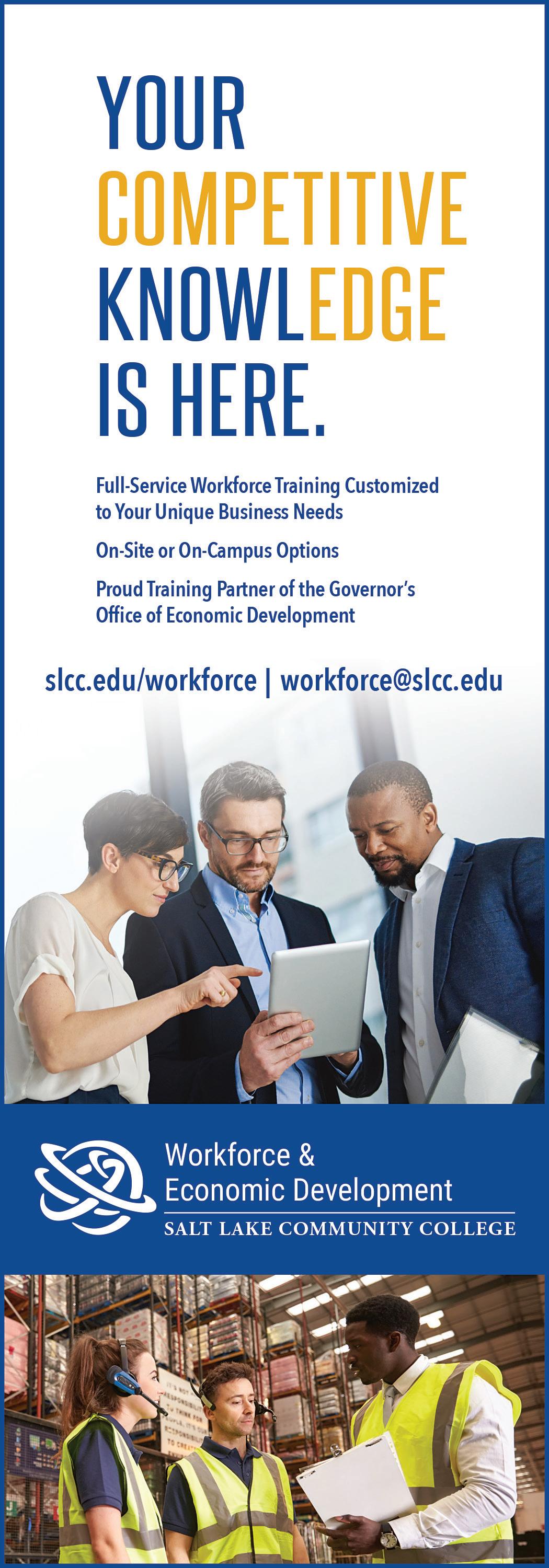






 Tby SAVANNAH KING
Tby SAVANNAH KING
he millennial generation is the largest in America with more than 75 million people a figure that represents almost two-fifths of the working age population. They’re also the most diverse generation in U.S. history with some 44% being represented by minorities.
In the last decade, Utah ranks No. 1 among the states for population growth. The Census Bureau estimates Utah’s current population at 3,161,105, with nearly 58,000 residents added in 2018.
According to a 2017 report by the Kem C. Gardner Policy Institute at The University of Utah, the state’s population is expected to increase from approximately 3 million to 5.8 million by 2065. Net migrations will account for


one-third of the increase, with the other two-thirds coming from natural increase (births minus deaths). The report indicates growth rates are projected to decrease over the next 50 years, but Utah will likely exceed national growth rates. Utah’s median age is also expected to increase, rising from 30.7 years in 2015 to 38.3 years in 2065.
Over the next 50 years, Salt Lake County will likely remain the most populous in the state. In the southwest corner of the state, Washington County is expected to have the most rapid rate of growth with over half a million new residents expected in the county by 2065.
Salt Lake City Sustainability Communications Manager Sophia Nicholas said, “Our millennials realize that living


Utah’s population is growing with no signs of slowing down


downtown is a fantastic choice if you’re seeking to reduce your impact on the planet. It’s easier to have a lower environmental footprint when you’re living in denser communities. It’s easier, cheaper and cleaner to use public transportation and to live close to where you work. Multi-family dwellings have lower resource requirements, and there are many local food options from downtown community gardens to the year-round local farmers’ market.”
Utah’s third largest city, Provo, is home to the largest share of U.S. young adults, according to a 2018 analysis from the Brookings Institution.
Ogden-Clearfield is also a millennial magnet with some 24.3% of the population in the city being millennial aged.
Millennials tend to value experiences over possessions. As such, they tend to migrate to larger cities where jobs are plentiful, neighborhoods are walkable, and quality of life is high. In Utah, millennials flock to Salt Lake City for its unique culture and attractions. In fact, the city ranked No. 4 in the annual Mayflower Index and Livability’s Top Ten Cities for Millennials on the Move.
Outside of the metro area’s urban assets, the area is surrounded by one of the best natural playgrounds in the U.S. with abundant parks, hiking and biking trails, and skiing. The nearby Wasatch and Oquirrh mountain ranges are popular destinations, as is the Great Salt Lake, which is saltier than the ocean and allows people to float effortlessly on the surface of the water.






Damien Patton, the founder and CEO of Banjo, gave his tech startup a simple mission: “save lives and reduce human suffering by getting everyone live, validated information so they can make better decisions faster.”
Born from Patton winning an engineering hackathon at Google in 2010, Banjo is the world’s first live-time intelligence platform that gives decisionmakers the ability to understand what is happening now anytime, anywhere. Banjo’s first patents were focused on protecting user privacy by delivering information without any personally identifiable data. A military veteran of Desert Storm and former crime scene investigator, Patton puts this experience to use by harnessing the power of big data to improve the lives of people.
In the realm of using information to make decisions, however, he admits that he wasn’t always sold on doing business in Utah. “My wife wanted to move to Utah,” he says. “I had nothing to do with it. We were living in Silicon Valley at
the time. She asked to move to Utah. I wasn’t very fond of that idea at first, but we have been here two years now. It turned out to be the best decision we ever could have made both personally and for our company.”
The corporate relocation began about two years ago when Patton moved five people from Banjo’s offices in northern California to Park City just outside of Salt Lake City. “We had no plans to move the company here at that time, but I started to quickly see how business-friendly the climate was and how much access to government we could have here,” Patton says of Utah. “That’s how it started. Our staff in Utah grew to 10 and then to 50. We will move our headquarters here from California by the end of this year, and we are committed to hiring at least 100 people in Utah. We made that announcement at the governor’s Utah Economic Summit earlier this year, and the new people are already being hired.”
What changed Patton’s mind? “I found out that the business climate in Utah is extremely friendly,” he says. “So is the climate for startups. Utah is very
Park City, Utah Photo courtesy of VisitUtahdifferent than the Bay Area. Getting access to people here is easier. Most of our customers are government. Governments at the state and local level in Utah are very welcoming of new technology and willing to take risks. That is a big testament to the leadership running the state. And the quality of life here is amazing. There is no traffic here.”
He also points to the clean air in Park City, access to a modern international airport, and the ease with which he can recruit highly technical people to move to Utah. “I have lived all over the U.S. and all over the world,” he says. “I have been accepted more in Utah than anywhere else in my life. It has helped me be very genuine in recruiting people to join our team in Utah.”

publication cited the facts that SLC is Utah’s most populous city and is home to 2,689 serial entrepreneurs, or about 0.23% of the population. SBT quotes Robert Brady, founder of Righteous Marketing, as saying, “The business community in Salt Lake City is phenomenal. The entrepreneurial spirit is strong, and founders are generous with their time to support the community.”
The Utah capital has competition in the entrepreneurship department, however. According to a study published June 5, 2019, by Verizon, Logan ranks as the best small city in the U.S. for growing new businesses and is joined in the top 50 by Taylorsville, South Jordan and Lehi. Verizon cites such factors as
“ I have lived all over the U.S. and all over the world. I have been accepted more in Utah than anywhere else in my life. It has helped me be very genuine in recruiting people to join our team in Utah.”
— Damien Patton, founder & CEO, Banjo

After running out of space in Park City, Patton and his team have already picked out new digs in the community and are set to complete their move into their new permanent headquarters space by December. “We are growing extremely fast here,” says Patton, whose firm also maintains offices in Redwood City, California; Washington, D.C.; and Las Vegas. “We are able to recruit people from all over the U.S. and the world to come to Utah.”
Banjo is far from alone. When Small Business Trends named Salt Lake City the Best American City for Serial Entrepreneurs on June 3, the online
a low state tax rate and the assistance that local businesses receive from Utah State University in helping to grow the Logan economy.
A third independent study, conducted by WalletHub, brought even more confirmation of Utah’s ability to support startups. In its annual ranking of the Best States to Start a Business, Utah ranks second only to Texas, WalletHub reported on July 8, 2019. The ranking was comprised of several data points, including Utah’s No. 2 placement in access to resources and No. 2 ranking in highest average growth in the number of small businesses.

 Tby THAD KELLING Marketing and Public Relations Director, Lassonde Entrepreneur Institute
Tby THAD KELLING Marketing and Public Relations Director, Lassonde Entrepreneur Institute
he David Eccles School of Business at The University of Utah is taking its top 10 ranked program for entrepreneurship to new heights with a master’s degree designed for serious entrepreneurs.
The degree is called the Master of Business Creation (MBC), and it’s the first of its kind.
Applicants must be full-time entrepreneurs who want to create, launch and scale a new business, who want more than the 9-to-5 job, who have the drive to overcome the impossible, who want to build their knowledge while doing, and who are willing to put in the hours to make it happen.
Founders can apply to join the program and learn more online (at Eccles.Utah.edu/MBC).
Provided in partnership with the Lassonde Entrepreneur Institute, the MBC combines the best of a graduate businessdegree program taught by leading scholars with a rigorous startup accelerator. It provides founders with the know-how, mentoring and support they need to launch a company and create their own job.
“The Master of Business Creation is unlike any other business master’s degree,” said Taylor Randall, dean of the David Eccles School of Business. “It will teach founders what they need to know to start and grow a successful company, and they will learn these lessons while applying them in real time to
their companies. MBC students can customize the program to meet their needs. No two companies are alike; we created a program that accommodates this diversity.”
MBC students complete the program in just nine months, while getting access to extensive resources, including significant scholarships, more than $500,000 in grants, mentors, prototyping tools, office space and more. Company founders graduate with the skill and knowledge to create and scale a new business, which is fundamentally different from managing an existing business.
To develop the MBC, the Eccles School talked with entrepreneurs hard at work in its existing programs. Students requested a degree focused on their idea that allows them to focus on making it successful.
“This degree program is very relevant and immediately useful for a working entrepreneur,” said Todd Zenger, presidential professor and chair of the Department of Entrepreneurship & Strategy at the Eccles School. “The Master of Business Creation degree was co-designed by serial entrepreneurs and leading educators to provide you with the tools, training and network access required to create and build a business, rather than merely administer one. Our aim is to assist entrepreneurs in what matters most to them — rapidly growing their startup and realizing its potential. We are just
as focused on that goal as our students.”
The Eccles School also looked at leading business accelerators that have been growing in popularity across the country and provide space and support to promising startups. Like these accelerators, the MBC program has a competitive application process and offers financial support and a cohort structure that allows founders to learn together.
“We created a graduate degree inspired by leading accelerators like Y Combinator,” said Troy D’Ambrosio, executive director of the Lassonde Entrepreneur Institute, an assistant dean at the Eccles School and a serial entrepreneur. “We wanted to create something similar, but with the unmatched resources and expertise of a top research university. Launching a company on campus has many advantages.”
“We want the program to enrich the participant’s startups, not be a drag on them,” D’Ambrosio said. “Everything we do is to support these founders. When a startup is just getting going, the last thing you want to do is to lose value and spend valuable time negotiating ownership. Founders should be focused on growing the company and putting capital into the business.”
Resources are made possible through generous sponsor support. Pierre Lassonde, the founder of the Lassonde Entrepreneur Institute and an Eccles School alumnus, and the Lassonde Family Foundation have donated $25 million to support entrepreneurship at the school. Zions Bank funds most of the grants. Other donors include
David Neeleman, founder of Jet Blue and Azul Airlines, the Larry H. & Gail Miller Family Foundation and many others.
MBC students receive training and mentorship from exceptional faculty at the Eccles School. To complete the program, students take courses on topics including developing and testing a business model, negotiation, law, accounting, strategy and leadership. In addition, students have access to a vast number of electives to meet any specific needs they have.
The Eccles School already has a record of success for supporting student entrepreneurs. It is ranked among the top 10 programs in the country for entrepreneurship by Bloomberg, U.S. News & World Report and the Princeton Review. Beyond the rankings, the Eccles School helps students launch hundreds of startup teams every year. During the 2017-18 academic year, for example, students launched 504 startup teams.
Off campus, MBC students have access to Utah’s thriving entrepreneur community and growing tech industry. Utah is consistently ranked as one of the top states for business. Business owners in the state enjoy a highquality workforce, plentiful funding opportunities and an uncommon quality of life that makes them want to stay.
“The Master of Business Creation is not for people who want to just think about entrepreneurship,” D’Ambrosio said. “At the Eccles School, entrepreneurship is a verb. The best way to learn is by doing it. If you have a great idea and are willing to do what it takes to develop it, this is for you. Come and entrepreneur with us.”




Utah is one of the top states in the nation for higher education, and for good reason
tah is the No. 2 state in the nation for higher education and consistently ranks among the top states in the country for high school completion.
A 2018 report by WalletHub named Utah the 11th-most educated state in America. After graduating high school, eight out of 10 students enroll in one of the state’s eight public colleges and universities. In the 201920 academic year, enrollment at Utah’s public colleges and universities increased to 184,000.
The Utah Promise Scholarship is the state’s first
needs-based scholarship program. It aims to open opportunities for students who face economic barriers and covers tuition and fees for the first two years of college for qualifying students when federal grants fall short. The scholarship is the newest of four major scholarships offered by the state.
“We are pleased to now offer a range of scholarship opportunities that will ensure Utahns have greater access to higher education,” said Harris H. Simmons, chair of the Board of Regents. “These programs support the board’s mission of helping more Utahns access
and complete a postsecondary education.”
Utah offers the fourth-lowest average tuition and fees ($6,956 in 2018-19) for public four-year institutions in the country. Lower costs translate into less debt. In fact, Utah has the lowest student debt in the country at $18,850 per student. Additionally, students in Utah have the lowest proportion of graduates with student debt.
According to updated enrollment projections from the Utah System of Higher Education, Utah’s public colleges and universities can expect to see more than 43,000 additional students over the next decade. The largest percentage growth is expected to come from Southern Utah University, at a 4.7% growth rate, with Dixie State University closely following at 4.4%. And, Utah Valley University expects to enroll nearly 56,000 students by 2028.
Utah has embarked on an ambitious plan to ensure that every public K-12 student in the state has the opportunity to learn computer science by 2022.
Utah will be the 12th state in the nation to develop and implement such a program. The Utah Computer Science Master Plan was developed through a generous grant from the Pluralsight One Fund and the support, input and engagement of subject matter experts and stakeholders across industry sectors, including members of the Talent Ready CS Committee.
“Computer science is now a foundational literacy that is critical to preparing Utah students to succeed in our technology-driven world,” said Aaron Skonnard, CEO of Pluralsight, co-founder of Silicon Slopes and member of the executive board of Talent Ready Utah. “Every school in Utah must teach computer science, and every student must have equality of opportunity to learn computer science regardless of whether they pursue a career in technology. With the approval of our state master plan, we now have a roadmap to achieve that outcome, and we are one step closer to delivering on Gov. Herbert’s goal of ensuring every K-12 student in Utah has the opportunity to learn computer science by 2022.”


he businesses and community members in Helper, Utah, are busy on many fronts creating a welcoming environment to attract both businesses and new residents.
by RACHEL DURAN“I am amazed and proud of the community and how we have pulled together over the last three years,” notes Helper Mayor Lenise Peterman. “With determination and grit we are making significant headway in creating our sustainable community.”
Helper is a community of 2,100 people in eastern Utah. This rural community is moving from an energy-based economy
where leaders are facilitating and building strategic partnerships with businesses and eliminating obstacles.
Helper encourages millennials, who choose where to live first and where they’ll work second, to bring their ideas and businesses to the city. There, they can take advantage of the area’s recreational assets, including the arts and history. Popular destinations include the Book Cliffs and the Western Mining and Railroad Museum.
The community is involved in initiatives such as The University of Utah’s Dark Sky Scholars program. Dark sky is an emerging field of study
that explores the impact of artificial light at night and the loss of night skies through a range of disciplines, according to a university press release.
We spoke with Peterman about how Helper can help business grow.
How would you describe your vision for a sustainable Helper?
• Helper is located 116 miles southeast of the Salt Lake City International Airport and 122 miles north of Moab, according to itshappeninginhelper.com.
• Helper is named for the “helper” steam engines used to assist trains traveling the steep grades through Price Canyon.
MAYOR LENISE PETERMAN: There are three tenets:
1.) attract young families to the area to replenish our human capital; 2.) overcome sinking revenue sales tax through economic diversity and stabilization; and 3.) expand our natural assets and take care of the environment we are fortunate to live in, utilizing that as an economic driver for visitors.
Tell us about the area’s natural assets and what you are doing to improve upon them.
PETERMAN: We are fortunate to be one of the few cities in Utah that has a river that runs through our downtown, the Price River.
We are restoring the river to its natural position because over the course of time railroad ties and cars were put in to mitigate flooding, build banks and so forth.
We just finished Phase V of a six-phase project, and every year I am trying to knock off another phase. At the end of Phase VI we will have a four-mile walking, running and biking corridor open for fishing, tubing, swimming and kayaking.
We want to put in a bridge that allows people to walk down Main Street and cross the river if they want to walk to the Family Dollar store going in. I also have a group of investors looking at the same space for a microbrewery. They are interested in the bridge.
The river project is an economic driver, as well as playing our historic card and
artistic component. I am fortunate to have a multitude of national artists who call Helper home. We want to leverage our environmental assets, our history and our sheer luck in having such a great artistic community, into a day trip destination.
How did the arts community develop?
PETERMAN: Artists swept in during the mid-1990s and purchased buildings cheaply on our Main Street and have turned them into working studios/ galleries. The community holds a First Friday event each month, closing down Main Street to encourage people to come downtown to listen to music, walk around and grab a bite to eat. This year is also the 25th Annual Helper Arts, Music and Film Festival. Helper also has a Christmas Town designation, celebrating the holiday in various ways and ending with a light parade and fireworks.
Describe the workforce businesses will find in Helper.
PETERMAN: Out of our 2,100 population, 1,500 people are of working age. I live in Helper but my job takes me to Price and Huntington — our people travel locally for work. Unfortunately, we suffer a great deal of intergenerational poverty and about 65 percent of the children in our elementary school are on free lunch. We are working closely with the schools because we want these kids to embrace a different life and to value education. And if need be, get trained and educated and bring their skills and talents back to us.

The community is working hard to see things change. “This is who we are, this is where we are going, and this is how we will get there. We are collectively behind that and pushing it forward in all sorts of amazing ways,” she said.
 by RACHEL DURAN
by RACHEL DURAN
Moab, Utah, has successfully tapped into its red-rock landscapes, fantastic scenery and cool river waters to form a wide-ranging, tourism-based economy. While this industry continues to thrive, Moab’s officials are actively pursuing initiatives to diversify their economy. The goals focus on unlocking entrepreneurial potential and investing in the community’s infrastructure.
Remote work opportunities are leading the way in the economic diversification efforts. More people are moving to Moab who work remotely. “In the past several years, when I ask people what they do, they tell me they work from home and work in investments, medical coding, as lawyers — things that aren’t tied to tourism,” says Moab Mayor Emily Niehaus. “They work out of a spare room in their homes or rent space downtown that has high-speed internet. Or they will work from a café during the day. It is growing.”
• Moab does not assess a property tax, but there are several sales taxes that apply.
Moab’s fiber network is under expansion to deliver even better internet services to residential areas. As a social entrepreneur and founder of an affordable housing organization, Niehaus knows first-hand the good and bad of starting a business in rural Utah. She says a main component to fostering an entrepreneurial climate is high-speed internet in order to communicate with the rest of the world.
• The Moab Business Resource Center located at Utah State University-Moab provides training and counseling for new and existing businesses.
• Moab welcomes approximately 1 million national and international visitors each year.
Source: moabcity.org
Another important aspect is a social framework that provides resources and training for licensing and how to use QuickBooks online, for example. “There are different segments in Moab that are doing services like that,” Niehaus says. “Just last year Moab put forth a community contribution grant fund to be able to support businesses doing things like that. And we have economic development help from Grand County as well.”
Let’s discuss the new vision for the future development of Moab.
MAYOR EMILY NIEHAUS: We are living the vision of our community leaders from 20 years ago. They wanted to see Moab grow as a tourism-based economy. We are there in full bloom. But this successful tourism-based economy has some unintended consequences. I think the new vision for Moab is emerging to be one that is regenerative and diverse within the local and visiting population, the economy and the environment. We
have the opportunity and current resources to diversify our economy, unlock entrepreneurial potential, and invest in our infrastructure.
Tell us about Moab’s world-famous recreational assets.
NIEHAUS: Our economy is tourism-based, but within tourism it is very diversified, more than most communities. We are seated between two national parks, which are part of Utah’s Mighty 5 program. [The parks are Arches National Park, and Canyonlands National Park, Island in the Sky District]. We are 30 minutes from the Delicate Arch. We are on the Colorado River and an hour-and-a-half north is Class V white water. Eighty miles south of us is Cataract Canyon, a mini Grand Canyon. In addition to big boats and kayaking, you can go multi-day rafting, which is unique to our county. And Moab is the mountain biking mecca of the world with the Slickrock Bike Trail [a highly technical, 9.6-mile trail.] Recreational opportunities are ridiculously accessible from our valley. Depending on what kind of recreationist you are, there is something for you here. Utah State University is underway with an expansion of its campus in Moab where they will continue their existing courses and look to expand its nursing program, and in time, its outdoor products major. Many students attend USU for outdoor products research and design, which is a pretty big industry. The Utah Office of Outdoor Recreation reports the state’s industry is worth $12.3 billion.

uchesne County, offers a unique combination of a top-ranked hospital, low-cost electricity, telecom connectivity that rivals metro areas, strong education assets, and outstanding recreational opportunities not often found in rural communities.
Like many rural communities, technology is projected to be a game changer for this county’s economy, opening doors for remote work opportunities and attracting entrepreneurs and former residents back to the community. One company has hired nearly 200 people to work from home entering data. The Utah Department of Workforce Services has added
positions in the community, part of a statewide effort to move some state positions to rural Utah communities. “We worked closely with Governor Herbert and his 25,000 jobs initiative,” says Irene Hansen, who heads up the Duchesne County Chamber of Commerce and who is also a county commissioner. The initiative, announced in 2017, aims to add 25,000 jobs to rural Utah within four years.
Hansen invites executives and entrepreneurs to imagine living and working from home in an area where housing costs are anywhere from 20% to 50% less than other areas. “Many tech firms don’t care where people live — they just want them to get their work done.” She adds that
technology makes almost every type of job “doable” from a remote location.
What is the county’s vision for economic development?
IRENE HANSEN:
• Duchesne County, the gateway to the Uintah Basin, is located northeast of Salt Lake City, and Duchesne City is one hour from Heber City, which was home to several of the venues for the 2002 Winter Olympics.
• The Uinta Mountain Range is the highest in Utah and is the only major range in the contiguous United States with an east-west orientation.
While the county has been a leader in the state’s oil industry — nearby Uintah County has been the No. 1 natural gas provider in the state — and has strong partnerships with the industry, the industry comes with highs and lows due to the volatility in international markets. We realize we aren’t very diversified and there are challenges to industry diversification. One of the challenges facing the Uintah Basin and the county is we don’t have rail, and that is being worked on. The area also lacks an interstate and is not located close to an international airport. However, the community features locally owned electric and telecommunications organizations, Moon Lake Electric Association Inc. and Strata Networks. It has been said many times that we are probably the top, most efficient, most dependable and lowest-cost electric service in the United States. Strata Networks features redundant fiber and companies experience better connectivity and redundancy here compared to larger communities.
Source: utah.com/uinta-mountains
It is a nonprofit and everything goes back into the community. What we have done here really can’t be duplicated and part of it is if you look at rural America, there have been more than 300 rural hospital closures.
Here in Roosevelt, the Duchesne County School District just built $100 million in new schools, including a high school that is within walking distance to a Utah State University campus and to Uintah Basin Technical College. Education is a big part of the reason why Roosevelt expands to 25,000 during the day.
These things are not normally available in a rural area. This also includes recreation. Duchesne City is the gateway to the Uintah Basin. We are home to the High Uintah Wilderness, which is the largest wilderness area in the state. People come from all over the world for recreation and corporate retreats. The basin also includes state parks, and there is a national monument in nearby Vernal, in Uintah County.

Describe the assets and resources that make Duchesne County unique among rural communities.
HANSEN: There are 8,000 people who live within a mile of Roosevelt; however, during the day we increase to 25,000 people who come here for shopping, education and services. Uintah Basin Medical Center located in Roosevelt employs more than 700 people and has been rated in the top five rural, locally owned hospitals in the nation.
We are almost a seamless community with Uintah County. We have great infrastructure, as well as state highways in our area. Highway 40 is one of the main thoroughfares to Denver.
This is rural America and it is not for everybody. But when you like that lifestyle, we are appealing. And of course, Utah is recognized for its great leadership and as a great place to live. All of the good things Utah has to offer extends into rural, less populated areas of the state.

As one of the nation’s top states for aerospace and defense, companies in these industries have a long history in Utah. They focus on the production, sale and service of commercial aircraft and the design and operation of military weapons and systems.
Chanel Flores, aerospace and IT cluster director with the Governor’s Office of Economic Development, helped explain some of the inner workings of the aerospace and defense industries.
“It’s interesting to see the ebbs and flows when it comes to aerospace and defense, because if defense is on the upward spiral, you’ll generally see a decline in commercial, or vice versa,” Flores said, adding that, lately, much has been related to defense in regards to contracts awarded by the federal government.
Utah is home to 46 airports as well as companies like Boeing, Hexcel, L-3 Communications, Northrop Grumman, Orbital ATK and many others, which provide employment to more than 33,500 people in Utah,
with a high concentration of aerospace engineers, materials scientists, machine operators and more.
The past couple of years have been eventful ones for companies here. Among the biggest milestones: Parker Hannifin Corp. announced it would move additional repair operations to Utah; Northrop Grumman acquired Orbital ATK; and Duncan Aviation announced an expansion that will add up to 700 jobs.
Flores said educational opportunities for those looking to work with companies in the aerospace field — like those above and more — are abundant, with seven institutions offering specialized programs and applied technology colleges in the state providing a pipeline of machinists, welders and composite techs. Many of these offerings are related to prospective jobs in advanced materials — a growing field.
“When we talk about advanced materials, it’s so broad, and composites specifically touches on so many industries,” Flores said. “It’s interesting to see the evolution of composites, which


were usually just used in aerospace, but not now. You see them used much more broadly.”
Composites play a huge role, with more than 14,300 workers and industryrecognized expertise in advanced materials applications and unmanned systems development.
In 2000, the Department of Defense mandated that one-third of its fleet be unmanned or autonomous — highlighting an already rich history in the field, with universities here having already been researching at great length in unmanned systems and similar technologies.
Flores said that organizations such as the Utah Advanced Materials & Manufacturing Initiative, the Society for the Advancement of Material and Process Engineering - Utah Chapter and the Association for Unmanned Vehicle Systems International and Deseret UAS focus in Utah on accelerating innovation and growth in advanced materials, engineering and unmanned systems.
In addition, the Utah Department of Transportation, in conjunction with the Governor’s Office of Economic Development, the Economic Development Corporation of Utah and the University of Utah have worked to collaborate on the Urban Air Mobility program, which aims to establish a framework for safe and effective autonomous aerial transportation.
“There’s quite a bit going on, and urban air mobility is going to continue to be a huge focus for us within the industry clusters,” Flores said. “I continue to think this is going to be a whole other realm … and it’s exciting to see what Utah’s capabilities are.”
Added Flores: “I think it’s going to be a great year and future for the industry.”









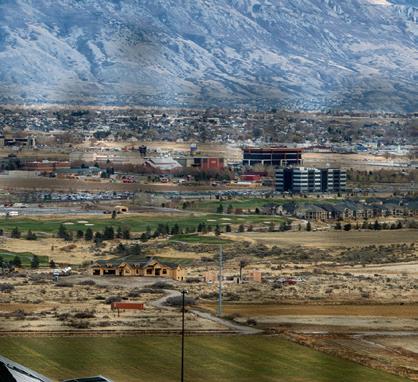




tah has a long history of natural resource development, particularly with its conventional resources — coal and natural gas. When Gov. Gary Herbert came into office, he wanted to continue to expand the space to develop these resources as well as drive innovation, responsible development, research, jobs and investment in the field.
by FRANK REDDY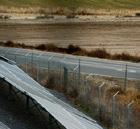


That was the foundation of his strategic energy plan, released in 2011, which continues to serve as a road map for the energy and natural resources industries in the state of Utah.
Updates to the initiative over the years, including last year’s Energy Action Plan, hone in on specific targets associated with the field that aim to continue growing energy and minerals development.
Dr. Laura Nelson, executive director of the Governor’s Office of Energy Development and energy advisor to the governor, said these areas focus primarily on rural business development, expanding education initiatives, having an energy efficient economy and energy policy with regard to regulatory matters.
“There’s been a lot of progress in rural business development, and one of the


key things we’ve seen coming out of that is continued expansion and diversity of our energy portfolios, including solar, wind, geothermal and energy storage,” she said.
Added Nelson: “That’s complementary to the resources we already have been developing over the last decades with coal, natural gas and petroleum products as well. Rural economies are the backbone of Utah’s energy ecosystem … and continuing to leverage the assets we have and building new opportunities has been critical for continuing to elevate Utah’s energy economy.”
Expanding education initiatives is another aspect Nelson highlighted as part of the Energy Action Plan. “We have a need to develop our workforce for the future,” she said. “It’s evolving to include more renewable resources and natural gas today, so we have to create the workforce that’s going to allow us to innovate in our current energy space.”
In order to do this, the state has enacted certain initiatives. For instance, the Office of Energy Development has provided $65,000 in energy scholarships to students pursuing advanced or technical degrees in energy and minerals education. The Office of Energy Development has also developed K-12
In the energy efficiency space alone, Utah has about 31,000 jobs
energy and minerals lesson plans for teachers to use in the classroom.
“That’s been a great initiative,” Nelson said. “It really informs students and gets them interested at an early age in pursuing other workforce opportunities they might not otherwise have considered.”
Having an energy-efficient economy is another area of focus. In the energy efficiency space alone, the state has about 31,000 jobs. Just last year, the state completed a project with a school district in Sanpete County that included a $7 million energy efficiency investment and created eight rural jobs, “providing a betterquality environment for the schoolchildren in that area.”
Finally, Nelson said, the state has been successful in driving effective energy policy in regulatory matters, “looking for the most efficient, most innovative outcomes across our energy systems.”
In the past couple of years, the Legislature has looked to advance energy technologies, particularly in rural communities. Examples include funding for methods that transform coal into carbon fiber, continued research in nuclear energy, and improved understanding of transmission systems to drive new energy development.
With more than 50,000 energy-related jobs in the state today and an average wage of $80,000 — 56% higher than other industries in the state — Nelson said Utah’s long history of natural resource development remains a huge success with a bright future ahead, both with conventional resources and the continued expansion of other types of energy.

The roots of Utah’s financial services industry run deep.
In fact, according to Al Landon assistant dean with the David Eccles School of Business at The University of Utah financial services has been “a rich source of economic advancement and opportunity going back to the beginning of statehood,” when colonists opened Utah’s first bank.
Today, roughly 75,000 people are employed in financial services with more than 6,100 establishments. Utah stands tall, ranking no. 8 in the nation for banking assets.
U.S. Bank and KeyBank, as well as newer entrances into the market and large companies like Goldman Sachs, Morgan Stanley, American Express and Discover.
In addition, Utah boasts a regional presence with companies like Zions Bancorporation. Meanwhile, credit unions have continued to be “an important part of our financial services sector.”

Landon said Utah is fortunate to have a wide range of financial institutions, including national players with significant presence such as

He said those involved with the financial services industry are also hopeful that industrial bank charters — also known as industrial loan companies “will be a source of renewed growth in the industry for us and an opportunity for financial technology firms to further innovate.”
Companies like Entrata, Snap Finance, SoFi, Varo Money and more are prime examples of the state’s growing fintech sector.
Overall, Landon said, the industry has been an important driver in Utah’s growth. While smaller than some states, Utah’s is one of the most diverse economies in the country. In 2015, the Tax Foundation ranked Utah’s Total Tax Climate as the nation’s ninth best.
Financial services is one of Utah’s largest and fastest-growing key industries, and home to 47 banking institutions, valued at nearly $600 billion.
The state’s credit union industry includes about 68 institutions, totaling $22.4 billion.
In 2018, to further expand and grow the financial services industry in Utah, the Governor’s Office of Economic Development partnered with Utah Center for Financial Services, aiming to identify opportunities for existing and new financial services businesses in the state, strengthen Utah’s financial service cluster, develop online
resources and collaborate with stakeholders — including financial service trade associations, investors, federal and state banking regulators and the Economic Development Corporation of Utah.
Utah Center for Financial Services is a research center partnering with the David Eccles School of Business at The University of Utah, where Landon teaches business leadership and banking courses and helps develop learning programs as well as directing Utah Center for Financial Services.
“We think financial services are the backbone of why Utah is such an attractive place to do business, because financing is available and our banks and credit unions are mature and do a great job of taking care of businesses and consumers,” Landon said. “We’ve also got a great safety record in the industry, and we’re a strong base for a growing economy.”















 by FRANK REDDY
by FRANK REDDY

While no state is fully recessionproof, because of the diversity of Utah’s economy, the state fared better than most in 2008, when the financial crisis struck, according to Clark Cahoon, life science cluster director with the Governor’s Office of Economic Development.
“During that timeframe, Utah did a good job because it has the most diverse economy in the country,” Cahoon said. “When you look at the six major industry clusters the state focuses on, the life science industry in general weathered it better than other industries.”

Added Cahoon: “Life science is a very resilient industry, because it’s diverse like Utah’s economy … it’s able to weather those cyclical or larger economic downturns better than others.”
Home to companies like BD Medical, BioFire, Edwards Lifesciences, Merit Medical Systems and Varian Medical Systems, Utah’s life science employee base is about 42,000 — one of the best in the country for the industry.

This includes a medical device manufacturing industry that produces 70 percent of all arterial and vascular access medical devices used worldwide. There are also many life science education resources in the state, with 11 institutions who offer programs in the field. In addition, Utah has a medical, dental, pharmacy and nursing school at The University of Utah.
Cahoon said that, in total,
there are more than 1,000 life science companies in Utah — meaning, companies that deliver technologies and services to improve personal health — accounting for over 130,000 direct and indirect jobs. Those companies generate $9.6 billion in total sales, while the industry as a whole accounts for $13 billion in state GDP, according to Cahoon.
A 2018 study by The University of Utah’s Kem C. Gardner Policy Institute analyzing the role of the life science industry in Utah’s economy found that the industry sold more than 40 percent of its 2017 output of $9.6 billion to in-state customers, “such that medical providers, pharmacies and other buyers in Utah did not require out-of-state alternatives for $4 billion in goods and services.”
About 60 percent of life science industry sales went to buyers in other states and countries, bringing about $5.6 billion to Utah, the report stated.
The industry in 2017 generated $475.8 million in net tax revenue — over one third of which went to counties and school districts, with the remaining 63 percent (nearly $300 million) accruing to the state, according to the report.
Cahoon cited another recent report that examined the life science industry’s growth from 2012-17. It found Utah’s industry growth to be 5% — topping the nation, with other states in the running like Georgia (4.4%) and Colorado (3%).
“Even out of those highperforming states, we topped that,” Cahoon said.






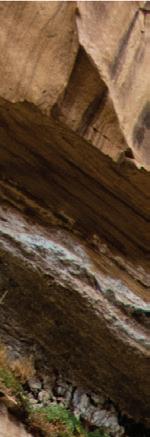




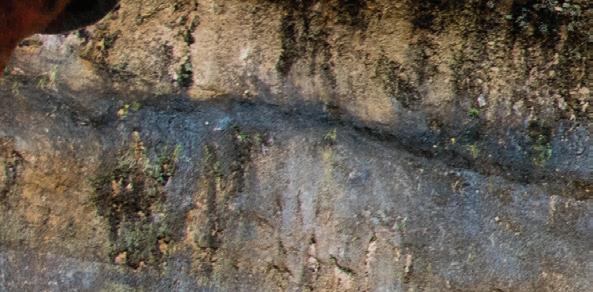



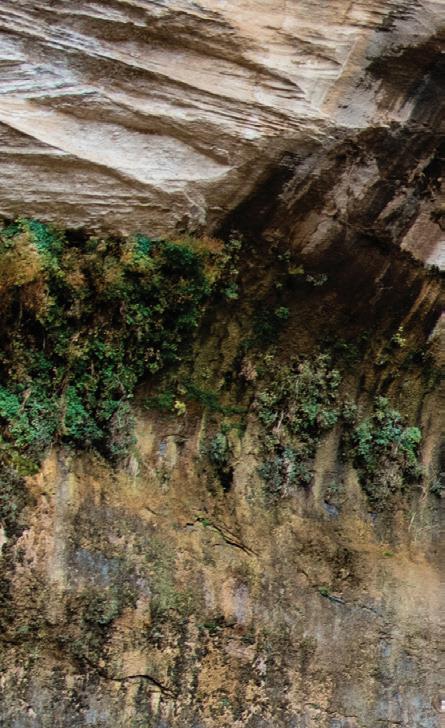

 Iby FRANK REDDY
Iby FRANK REDDY
t’s been said by some that nature plays favorites
— and for those in Utah who enjoy the wide range of outdoor recreational opportunities available here, it certainly seems a fitting maxim.
Thanks to the variety of outdoor recreation destinations and the short proximity between them, visitors too can maximize their time, exploring in short order Utah’s natural splendor.




Tom Adams, director of the Utah Office of Outdoor Recreation, said any given outdoor recreation enthusiast could fly into Utah early in the morning, speed down the slopes at a ski resort, drive




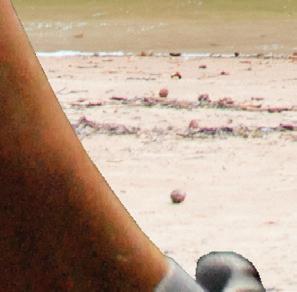

out to the desert for an afternoon rock climb or mountain bike session and wrap up the day trout fishing a burbling stream as the sun sets over sparkling river waters.
“You have such a wide diversity of landscapes and world-class recreation of all types from corner-to-corner of the state,” Adams said. “Utah is also a pretty phenomenal place when it comes to the outdoor industry, because logistically you can get product here fast and you can ship it out to retailers quite fast as well.”

Added Adams: “Some of the biggest retailers in the country are within two days shipping from here, so you can ship large quantities to their distribution centers to disseminate around, and it’s quite effective. With logistics as well, it comes back to the geography here in Utah.”




The outdoor recreation industry has a huge impact in the state, contributing more than $12.3 billion to the economy, employing more than 110,000 people and generating $737 million in state and local tax revenues.
Gov. Gary Herbert in fact created Utah’s Office of Outdoor Recreation the first of its kind in the country in January 2013 due to the industry’s large, continued contribution to the state’s economy.


The office aims to establish nationwide recreation management standards and ensure all the gorgeous natural assets of Utah can sustain this proven track record of economic growth for years to come.
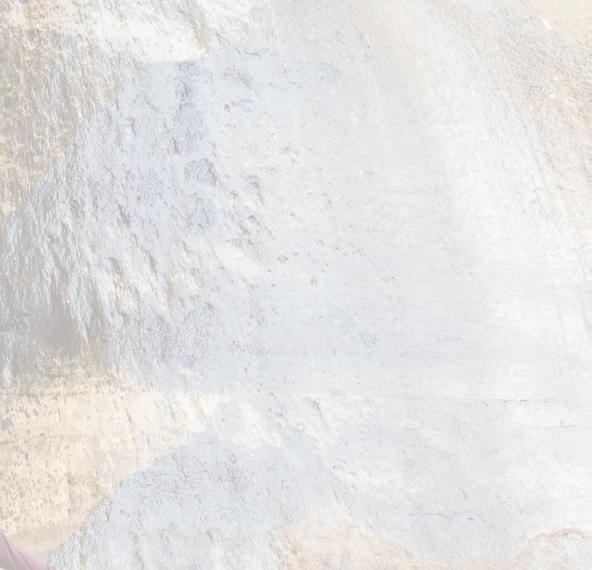
the longest-running outdoor recreation programs in the country and recently celebrated its 50-year anniversary, while Southern Utah University “is producing some of the best land managers in the country with their program.”
Workforce development in the outdoor recreation industry is “so far ahead of the rest of the country and even in parts of the world and, that helps us in terms of pushing highlyqualified individuals out into the workforce.”

Adams said much of the economy’s success is owing to the state’s workforce, with seven universities offering four-year degree majors in outdoor recreation including Utah State University, which recently saw its first graduating class for the nation’s first-ever outdoor product design and development program.
Much of that workforce includes those who manufacture outdoor products.
It makes sense that Utah’s outdoor products should continue to play such a large role with 54 million acres of public land, five national parks, 43 state parks, 14 ski resorts and thousands of miles of world class mountain bike trails.


“These are students who graduated and instantly get to go to work for great companies,” Adams said. He added that The University of Utah has one of

“We’re probably one of the few places in the world where you could fully outfit yourself to go hunting, fishing, snowboarding, mountain biking and road biking, and every single product you take for the day could be from a company here in Utah … as with many things in this industry, it all comes back to our unique geography.”




 by FRANK REDDY
by FRANK REDDY
The tech industry is booming in Utah. In a word, it’s “massive,” according to Chanel Flores, IT and software cluster director with the Governor’s Office of Economic Development.
In fact, one in seven jobs in Utah has an IT or tech component, Flores said. She added that the state’s growth in the industry exceeds the national average by four percent.
According to a February 2019 Industry Snapshot of Utah’s tech industry — researched by The University of Utah’s Kem C. Gardner Policy Institute — total economic impacts during 2017 exceeded 302,000 jobs at companies that paid $20.1 billion in earnings, generating $29.9 billion in GDP.
In addition, in-state spending by tech companies and workers supported nearly 186,000 Utah jobs outside the tech industry.
Flores said this overlap is an important aspect of the IT and software industry.
“Because we have such a strong presence within this industry, you’re seeing it touch or trickle into every other industry,” Flores said. “Even in the last year, we’ve seen huge Silicon Slopes momentum, and we’re seeing an upward tick in particular in how many engineers people are hiring as well as computer scientists and software engineers.”
According to Utah’s Tech Sector industry profile — in addition to being known as Silicon Slopes — it ranks second in the nation in fastest-growing
states for tech jobs, with an increase of 6.8% in 2016.
Utah is home to companies such as Adobe, Ancestry, Domo, IM Flash Technologies, Qualtrics and many more, boasting an employee base of more than 60,000.
“It’s such an entrepreneurship-strong environment we have created, and we have so many different companies that are actually out of Utah,” Flores said. Many of those companies have had big expansions over the past couple years.
For one, in 2018, Centrify announced an expansion and growth of its engineering team in the state — adding up to 200 jobs, $2.7 million in new state revenue and an estimated $4.5 million in capital investment.
In June 2017, Facebook made public its plans to build a one million-square-foot data center in Eagle Mountain, bringing $750 million in capital investment. The same year, Snapchat chose Utah for a future expansion; AvidXchange expanded its Utah operations; Pluralsight did the same, adding about 2,400 jobs; and, Adobe announced it would also expand, adding 1,260 jobs in Lehi.
“Not even 10 years ago, if you were to drive through Lehi, you’d see maybe one or two buildings there, but now it’s become almost like downtown Salt Lake City, with massive buildings everywhere,” Flores said, adding that, “it’s been amazing seeing this kind of growth, across all industries, but this momentum in the IT space has been truly incredible.”
Photo: Getty Images






















 Oby ADAM BRUNS
Oby ADAM BRUNS



n nearly the same day Utah was celebrating the 150th anniversary of the completion of the Transcontinental Railroad in Promontory, another milestone involving railroads, regional infrastructure and the future of U.S. transportation took place in the Northwest Quadrant on the outskirts of Salt Lake City.
That’s where Switzerland’s Stadler Rail in May 2019 celebrated its new U.S. headquarters and train production facility, along with such invited guests as Gov. Gary Herbert, Lt. Gov. Spencer Cox, U.S. Senator Orrin Hatch and












U.S. Ambassador to Switzerland Ed McMullen. As part of the celebration, Stadler re-enacted the historic meeting of the trains at Promontory Point with the company’s own electric and diesel trains for Caltrain and TEXRail.
“Today it is a great pleasure to present a car body of the first double-deck train being manufactured for the USA as well as the last FLIRT for TEXRail,” said Executive Chairman of the Board of Directors of Stadler Rail Group Peter Spuhler. “To a high degree, these trains were built right here in Salt Lake City.”












































The cars are just part of contracts with multiple locations around the country worth hundreds of millions of dollars.
“It feels great to permanently take root in Salt Lake City and celebrate the beginning of a new age in railroading,” said Martin Ritter, president and CEO of Stadler US Inc.
As the company described it when breaking ground for the site in 2017, “when Stadler received a major contract
from Caltrain for the construction of 16 bi-level trains in August 2016, the company quickly realized it would need a larger production space. The decision to stay in Utah was based on the state’s outstanding economic conditions and its political environment which ensured widespread support from the governor’s office and other authorities in Salt Lake



City and Clearfield, as well as in Davis and Salt Lake Counties. The decision was also swayed by Utah’s dedication to public transport, the state’s proximity to existing customers on the West Coast, and a workforce of enthusiastic and welltrained workers, who after nine months were already 115 strong.”
After about 18 months of construction, the new production facility near thehe airport was completed this year. All operations were transferred from a leased site in Warm Springs to the new 62-acre site in April. The company’s immediate footprint will be around 230,000 square feet and 350 employees, but that could grow to 900,000 square feet and 1,000 employees by 2029, the company has projected. The expansion, in the works for several years, is eligible for a post-performance-based $10.1 million incentive package from the Governor’s Office of Economic Development.



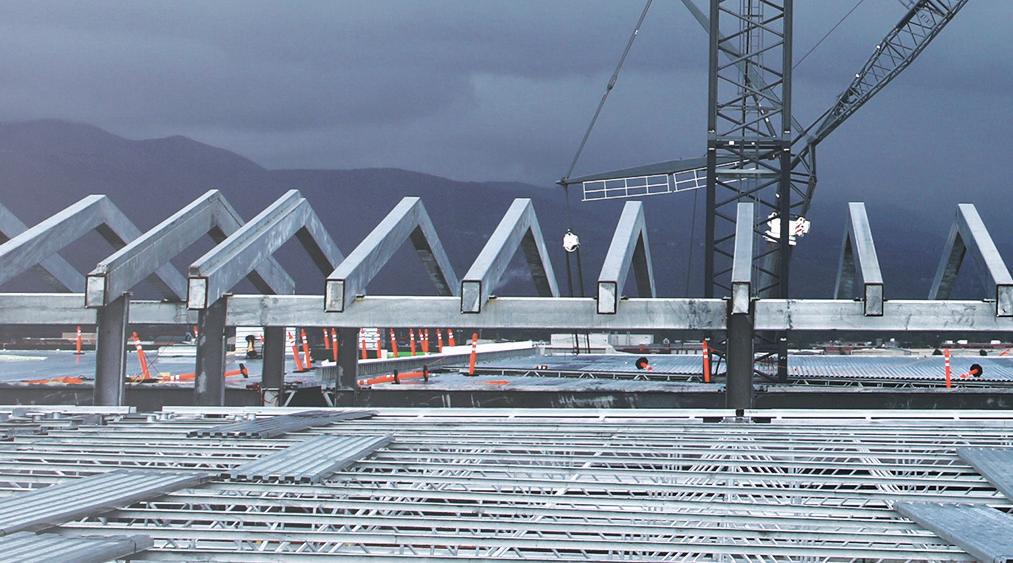
“The American Public Transportation Association and its more than 1,500 member systems and businesses applaud Stadler’s investment in the future of public transportation. The new U.S. production facility strengthens our industry and advances modern mobility in America,” said Paul Skoutelas, president and CEO of the American Public Transportation Association.
The facility is grandfathered into a region now welcoming the Utah Inland Port — a project not without controversy (mostly due to potential increased emissions from increased traffic) but most definitely with promise. Under existing zoning rights, more than 150 million square feet of industrial development could be built in the Inland Port area. As one proponent put it in recent public meeting minutes, “It’s



not a question of whether the area will develop, but of how.” And the Inland Port is one way to both guide metro-area growth and prosper from it.
The 38 square miles to be overseen by the Inland Port Authority include land owned by Salt Lake City, West Valley City and Magna. The area will serve as a special trade zone where inbound and outbound goods are processed, bypassing coastal ports of entry. Utah has become a significant distribution hub for the western U.S.
Stadler, for one, was confident enough in the area to already start installing infrastructure. “When construction began in early 2018, the area was mostly undeveloped,” the company stated in March 2019. “Together with CenturyLink and Centracom, Stadler has installed
Port has more connections than rail to California ports: In June, Jack C. Hedge, former director of cargo and industrial real estate for the Port of Los Angeles, was named executive director of the Utah Inland Port.
“Hedge’s experience at the Port of Los Angeles will be a valuable asset as we guide the development of the Northwest Quadrant,” said Derek Miller, co-chair of the Utah Inland Port Board Authority. “His knowledge will be insightful as we expand economic opportunity and international trade while mitigating the impacts to air quality, traffic congestion and recreational habitats for our great state.”
For Stadler Rail, a human infrastructure project could be the most meaningful in the long-term, as
“The inland port is a once-in-ageneration opportunity to ensure Utah’s place as a center of commerce for the Western United States.”— Derek Miller, Chairman, Utah Inland Port Authority Board, October 2018
a fiber backbone to deliver light-speed internet access to the Stadler site, the Northwest Quadrant and future development. Stadler worked with local rail provider Salt Lake Garfield and Western (SLGW) to install an industry rail spur connecting the new facility directly to the U.S. national rail network via their services. This connection allows materials from around the world, shipped to receiving ports such as Long Beach or Houston, to be transported directly to the facility via railways and rolled into the receiving hall for unloading and loading.”
As it happens, the new Utah Inland


Theresa Mbaku, career and technical education director for the Salt Lake City School District (SLCSD), and Megan Ware, human resources manager for Stadler Rail, recently explained at an Inland Port Authority public meeting. Via collaboration among SLCSD (home to 25,000 K-12 students), Salt Lake Community College, Stadler Rail, the Governor’s Office of Economic Development and the Department of Workforce Services, the district’s CTE pathway program — designed to connect high school classes to college, industry certifications and/or a career — is working with Stadler’s “earn and learn”
apprenticeship program, which includes paid-work and educational components.
“Individuals get relevant skills and knowledge with zero debt and the company benefits in recruiting, training and retaining talent,” said the meeting minutes. “Students come out of the 3-year program (senior year of high school and two following years) with an associate’s degree. [Inland Port Authority] Board Member [Ben] Hart emphasized the value of this program and said this is one way that the inland port can provide something meaningful to the community. He hopes this work-based learning model can expand through the state.”
Utah Inland Port Authority vice chair James Rogers “expressed his support” for the program, said the meeting minutes, “saying this is what he hopes the rest of the industry in the inland port will be doing.”
Hart, the deputy director of GOED, mentioned that this program has inspired legislation to create a statewide apprenticeship effort, and GOED’s Talent Ready Utah program will be working with industry and education around the state to create similar programs.
That could be made easier by a new amendment to the port authority’s enabling legislation that creates a huband-spoke model similar to that found in other states establishing the authority jurisdictional land as a project area and allowing for other project areas to be created in other parts of the state, with the consent of the local governing body and the landowner.
The Utah Inland Port area is one of the few remaining undeveloped areas of Salt Lake County. It sits at the intersection of two interstate freeways, major national railways, and an international airport which puts the area in high demand for expanding warehouse, distribution and manufacturing, says the Utah Inland Port Authority. In addition, Utah’s population will nearly double in the coming decades,
creating the need for more jobs and greater ability to move people and goods.
Increasing that ability is the $3.6 billion Airport Redevelopment Program under way at Salt Lake City International Airport (SLC, in air traffic parlance).
“The 13-year impact of new construction for the Airport Redevelopment Program, increasing visitor capacity as well as convenience and sustainability, is estimated at $5.5 billion total output to the economy of Utah and 3,300 annual jobs during the life of the project. The vastly more important contribution of airport services to business location, success and expansion though difficult to measure puts the airport at the center of successful growth for the state of Utah.”
So reads analysis published in September 2018 by GSBS Consulting, which observed that the facility currently “serves more than 25 million passengers a year from facilities that were designed 50 years ago, which were intended to serve half as many travelers.”
In other words, the facility doubling to come merely builds on the passenger doubling that’s already occurred.
Highlights of the new SLC, which will be “the first new hub airport to be built in the U.S. in the 21st century,” include already completed parking lot and rental car facilities, opened in 2014 and 2016, respectively.
Highlights to come include a 3,600-stall parking garage; growth from 71 gates (55 with jet bridges) to 78 gates, all with bridges; 16 TSA screening lines; and 4 million sq. ft. of facilities overall on a footprint of 297 acres, part of total airport acreage of 7,800 acres.
In March, a topping-off ceremony took place at the $850 million North Concourse building, which was not part of the original redevelopment plan but was added in spring 2016 because of tremendous passenger growth. Phase two of the entire redevelopment is projected to be complete in 2024 or 2025.

What could road sensors and oatmilk possibly have in common? And what is oatmilk? The answer to the first question: the foreign-owned companies making those products are investing in Utah, where nearly 48,000 people work for nearly 500 companies based outside the United States. Oatmilk is an oat-based drink produced using patented enzyme technology that turns oats into nutritional and liquid food.
Swedish food and beverage company Oatly, which makes oat-based drinks and foods, is opening a facility in Ogden that will employ 50 over the next several years. “Through this partnership with the state of Utah, our upcoming factory in Ogden will help us keep oatmilk in all the many coffee shops, grocery stores and refrigerators that want it,” noted U.S. general manager Mike Messersmith.
Panasonic and the Utah Department of Transportation formed a partnership in June 2019 to build a transportation data
network to improve safety and mobility on the road by sharing data between vehicles, infrastructure, roadways and traffic operators in real time. Japan-based Panasonic will help UDOT install intelligent sensors along selected sections of Utah highways. The partnership will boost Utah’s readiness to accommodate the incoming wave of smart vehicles that are more connected, more autonomous, and able to operate more safely and more efficiently through communication among vehicles as well as the infrastructure — including signs, signals and other sensors.
Utah’s foreign direct investment employment has grown more than twice as much as the state’s overall private-sector employment over the past five years — 46% vs. 20%, according
to the Organization for International Investment. Companies based in the United Kingdom, France and Germany (including BAE Systems, bioMérieux and Boehringer Ingelheim) employ the most Utahans. More than a third — 37% — of FDI jobs in the Beehive State are in the manufacturing sector.
Exports from Utah were up 24% in 2018 over 2017 total exports ($14.3 billion, up from $11.6 billion), according to Census Bureau data. The UK is by far the largest recipient of goods produced in Utah at just over $5 billion of the total. That’s a 119% jump from the previous year’s $2.3 billion. Rounding out the top five export destinations are Canada ($1.8 billion), Japan ($811 million), Hong Kong ($738 million) and Mexico ($725 million).
Gold (unwrought) — $6.1 billion
Integrated circuits — $597 million
Food preparations — $522 million
Civilian aircraft, engines and parts — $375 million
Safety airbags $326 million
Medical supplies $321 million
Bituminous coal $228 million
Nonelectronic graphite or carbon items
$215 million
Beauty and skin care preparations
$170 million
Essential oils $155 million
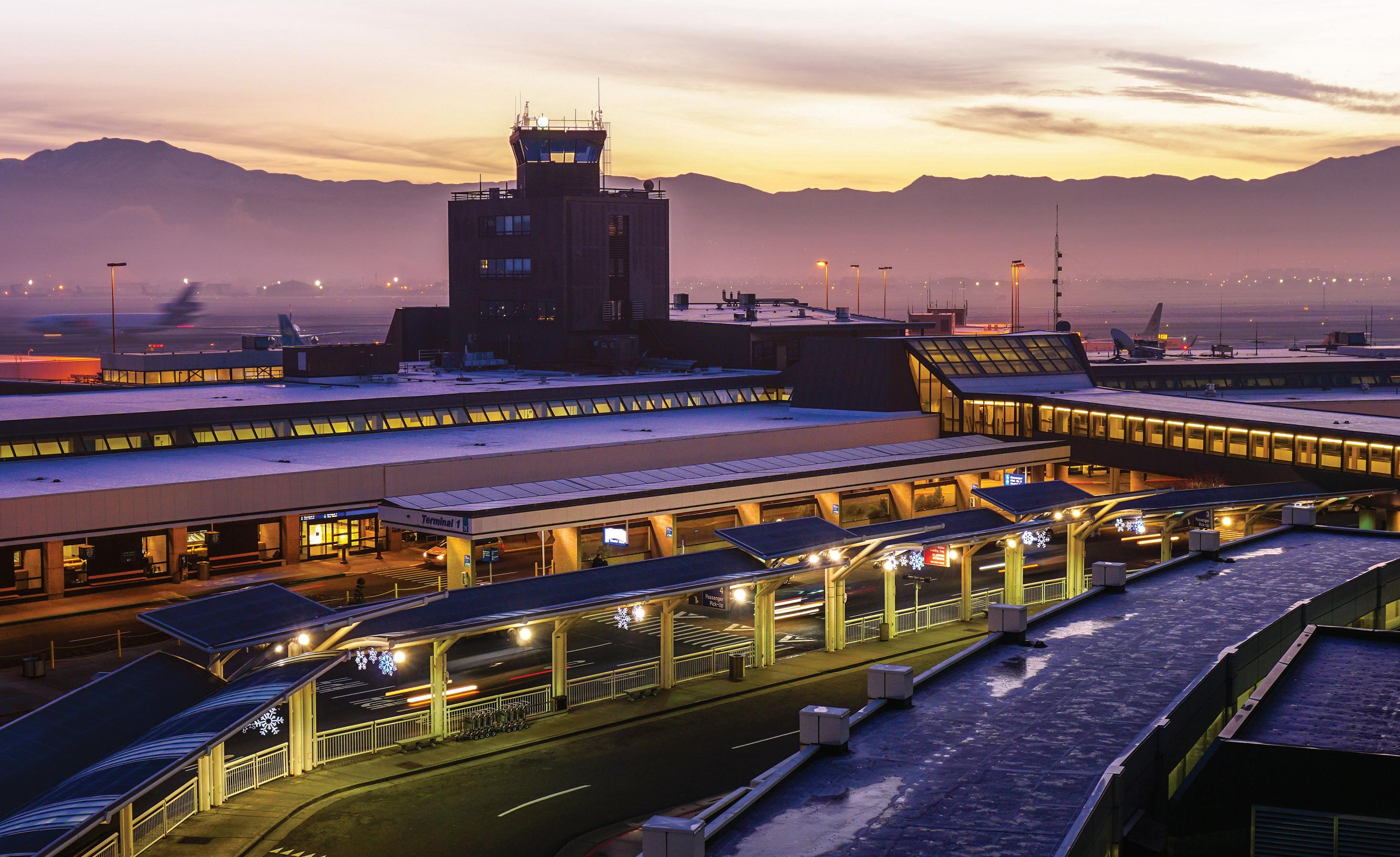


 by GARY DAUGHTERS
by GARY DAUGHTERS
tah considers itself the Crossroads of the West, a designation it claimed in 1869, when two rail lines were joined north of Great Salt Lake to form the fi rst transcontinental railroad. The impact would be dramatic, with travel time between America’s east and west coasts reduced from a matter of months to less than one week. Marking the event’s 150th anniversary last May, Transportation Secretary Elaine Chao told some 20,000 celebrants that the railway represented “one of the greatest infrastructure projects” in U.S. history.
Infrastructure — whether rail, roads, energy, water or now broadband remains as integral to life and commerce in Utah as it was when that spike was driven. As just one example, Salt Lake City International Airport (SLC), now undergoing a $3.6 billion transformation, generates an estimated $1.1 billion in annual wages and income from an estimated 35,290 full-time
jobs. SLC’s annual contribution of $1.9 billion represents close to 2% of Utah’s GDP. The airport, which offers non-stop fl ights to more than 100 cities, is served by 10 airlines and acts as a major hub for Delta.
Originally built to accommodate 10 million passengers a year, the rebuilt Salt Lake City International will represent an increasingly robust economic driver, one better capable of handling the 26 million passengers it serves now. The rebuild, itself, to be accomplished in two phases, is projected to inject some $5.5 billion into the local economy while creating more than 3,300 jobs. The new airport will have one large, central terminal and two linear concourses connected by a passenger tunnel.
In 2018, the Utah Transit Authority (UTA) marked the 10th anniversary of its FrontRunner commuter rail system that spans an 89-mile corridor through the state’s heavily populated Wasatch Front. FrontRunner serves a total of 16
stations from Provo northward through Salt Lake City and up to Pleasant View, just north of Ogden. Trains run Monday through Saturday with 30-minute frequency during peak times, and stations allow riders to connect to bus routes and to UTA’s TRAX light rail system. In operation since 1999, TRAX features three lines: the Blue Line from Draper to Salt Lake City, the Red Line from South Jordan to the University of Utah and the Green Line from West Valley to SLC. The system is comprised of 42 miles of track serving a total of 50 stations. TRAX runs seven days a week with 15-minute frequency during peak times.
Also spanning the Wasatch Front, I-15 connects Salt Lake City southward to Las Vegas, Los Angeles and San Diego and runs northward through Idaho and Montana all the way to Calgary, Alberta. I-80, which also passes through Salt Lake City, extends from San Francisco to Chicago. Currently under construction, the $335 million Mountain View Corridor will develop into a 35-mile freeway from I-80 in Salt Lake county to S.R.73 in Utah County. It’s the state’s biggest current road project. In all, the Utah Department of Transportation currently is directing 169 road improvement projects totaling $2.1 billion. “Live Electric,” a collaboration of the U.S. Department of Energy, Utah Clean Air Partnership, Utah Clean Cities and other state and local organizations, is a newlyestablished electric vehicle corridor along I-15 that’s to include some 700 charging stations by 2021.
The Utah Broadband Outreach Center is a public/private partnership devoted to extending broadband infrastructure throughout urban areas and across the state’s vast rural regions. Utah currently ranks as America’s 10th most connected state, according to the tracking service Broadband Now, with 96% broadband coverage. The Utah Telecommunication Open Infrastructure Agency (UTOPIA), is a governmental agency that builds broadband infrastructure and leases
it out to private internet service providers.
Energy costs and reliability being a key component of infrastructure, Utah offers enough advantages to make other states envious. Utah’s average electricity rate of 10.74 cents per kilowatt hour ranks sixth-lowest in the country, as measured by the online energy marketplace, ChooseEnergy.com. A net power supplier to other states, Utah generates more electricity than it consumes. The state’s average natural gas price of $7.58 per thousand cubic feet is the nation’s third-lowest.
Utah’s average electricity rate ranks sixth-lowest in the country
Solar Powered
Arid and with abundant sunshine, Utah is among the states with the most solar resources. Wind, hydropower and geothermal resources also are major contributors to the state’s renewable portfolio; about 14% of Utah’s net electricity generation came from renewable sources in 2017.
Utah’s five oil refineries, all within the Salt Lake City region, represent 30% of the refining capacity in the Rocky Mountain region. Pipelines deliver refined products to Idaho, Nevada, Wyoming and eastern Washington and Oregon.
The White Mesa Uranium Mill in southeastern Utah process all the domestic uranium contained in fuel rods at U.S. nuclear power plants. As the nation’s only operating uranium mill, it processes uranium ore from around the country with a licensed capacity of eightmillion pounds per year. The mill also produces high-purity vanadium, used in jet engines, axles, crankshafts, springs and cutting tools.


























































































With its vast mountain ranges, other-worldly National Parks, pristine lakes and rivers and the “Greatest Snow On Earth,” Utah is worth an adventure unto itself. That’s the estimation of the famed Michelin Green Guide, which has bestowed upon Utah a singular designation: In 2018, the Michelin Guide awarded Utah three stars, the first-ever such ranking conferred upon a state by the esteemed bible of travel.















































 by GARY DAUGHTERS
by GARY DAUGHTERS






















Citing Utah’s “high quality of service” and “the beauty of its world class landscapes,” the Guide identified Utah as a state “worth making a special trip for American and international visitors.”
In ever greater numbers, tourists are voting with their feet. In 2017, the last year for which records are available, visitors to Utah spent a record $9.15 billion, which supported 148,000 jobs and resulted in $1.34 billion in state and local tax revenue, according to the Utah Office of Tourism in the Governor’s Office of Economic Development. Travelers also purchased more hotel rooms and spent more money on arts, entertainment, recreation and restaurants in Utah than ever before.
From a visitor’s standpoint, outdoor Utah is a feast for all seasons. The warmer months mean hiking, climbing, biking, hunting and fishing among prodigious mountains, deep desert canyons, stunning rock formations, and virgin forests, lakes and streams. For winter sports, Utah offers 14 ski resorts, 10 of which are less than an hour from Salt Lake City International Airport. According to Ski Utah, the state’s average “snow density” of 8.5% yields a mix of dry, fluffy powder and wet, heavy flakes, perfect for skiing and boarding.
Only Alaska and California feature more National Parks than Utah. Known as the Mighty 5, Utah’s Bryce Canyon, Zion, Capitol Reef, Canyonlands and Arches National Parks cover a combined 1,300 square miles and host more than 10 million visitors each year.
Zion National Park in extreme southern Utah is the state’s most visited park and the third-most popular in the country. Zion welcomed 4.32 million visitors in 2018, slightly down from its record of
4.5 million in 2017. Bryce Canyon enjoyed a record 2018 with more than 2.6 million visits, up 108,000 from 2017 and 1.6 million from 2010.
While Zion is known for its colorful sandstone cliffs, bewitching “hoodoos” greet guests at Bryce. The tall, skinny spires appear in greater abundance in the park’s cathedral-like northern section than anywhere else in the world, according to the National Park Service. Ranging from human-size to well over 100 feet tall, hoodoos are the products of 40 million years of erosion and “frostwedging,” the geological process of weathering caused by water seeping into cracks, freezing and expanding.
In addition to the Mighty 5, Utah features 11 national monuments, five national forests, two national recreation areas, a national historic site and 43 state parks. While most of these stunning, natural assets are found in the southern half of the state, northern Utah offers compelling attractions, as well, such as Hill Aerospace Museum at Hill Air Force Base, Ogden’s Eccles Dinosaur Park and the Ogden Nature Center, Lagoon amusement park in Farmington and Antelope Island State Park in Syracuse.
Throughout the year, Utah hosts numerous arts events, including the Moab Music Festival, Tuacahn Theater Series, Utah Arts Festival, Utah Festival Opera and the Utah Shakespeare Festival. This is not to mention the annual Sundance Film Festival, the state’s most popular








arts happening, which draws more than 100,000 guests to Park City each January. Launched in 1978, Sundance has evolved into an international beacon of independent filmmaking and has served to propel such indie classics as Hoop Dreams, Reservoir Dogs, Paris is Burning, and Sex, Lies and Videotape.
Artisanal chocolate, anyone? Utah, according to foodandwine.com, enjoys “one of America’s most compelling chocolate scenes, one any chocolate lover should know more about.” A burgeoning farm to table movement is being forged by inventive chefs at eateries such as Tupelo in Park City, Block Restaurant in Provo, Table X, Pago and Vertical Diner in Salt Lake City and Hell’s Backbone Grill & Farm in the remote Boulder, population 225.
And who would have guessed that Salt Lake City is home to some thriving breweries and distilleries? These include Beehive Distilling, the state’s first postprohibition producer of gin, Waterpocket Distillery, named for the Waterpocket Fold in Utah’s Capitol Reef National Park, and RedRock Brewery, maker of exotic beers such as Elephino, Golden Halo, Le Quatre Saison, Frölich Pils and a seasonal Belgian ale called Rêve.























Ashley National Forest,
in northeastern Utah, is one of Utah’s pristine wilderness locations.
Snow Canyon State Park’s ancient sand dunes and lava flows.
Elk and other wildlife are often found foraging in Utah’s many state and national parks.





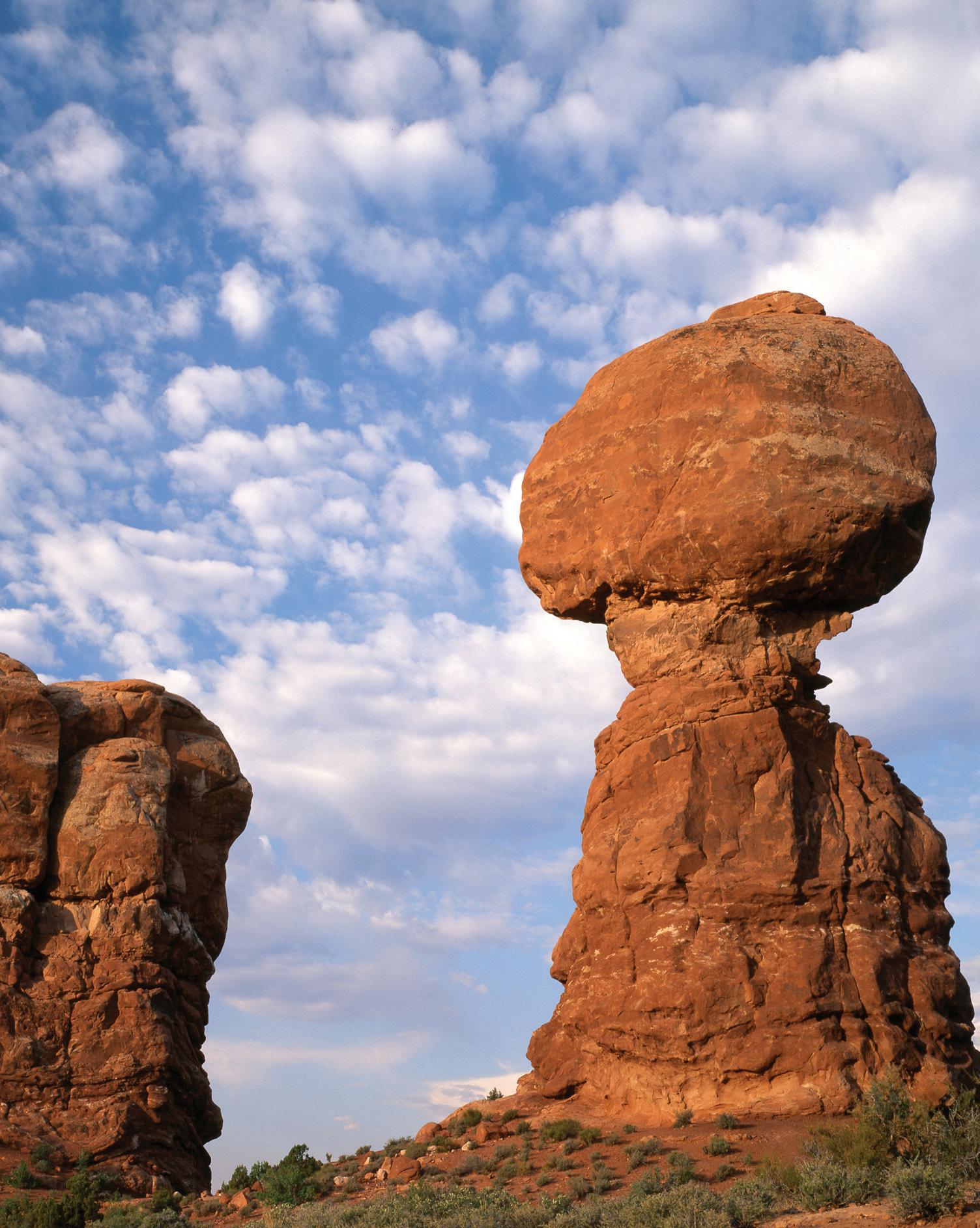
Balanced Rock is located in Arches National Park near Moab.
A couple hikes The Narrows in Zion National Park near Springdale, Utah. Here, the Virgin River has carved a spectacular gorge in the upper reaches of Zion Canyon: 16 miles long, up to 2,000-feet deep, and at times only 20 to 30-feet wide. The Narrows, with its soaring walls, sandstone grottos, natural springs, and hanging gardens can be an unforgettable wilderness experience.
Sundance Mountain Resort is a ski resort located 13 miles northeast of Provo. Spanning over 5,000 acres on the slopes of Mount Timpanogos in Utah’s Wasatch Range, alpine skiing began on the site in 1944.
All Images courtesy of VisitUtah




A skiing down a snow-covered slope while the tram passes on the cables above her on a blue bird spring day at Snowbird Ski Resort in Little Cottonwood Canyon near Salt Lake City.
Photo by Scott Markewitz Photography/VisitUtah
A woman hikes in Goblin Valley.
Photo by Michael Kunde Photo/ VisitUtah
Canyonlands from Green River Overlook



Beaver
Box
Cache
Carbon
Daggett County Econ. Dev.
Davis
Duchesne
Garfield

